Six considerations for storing hay outlined by BCRC Page 6
4-H livestock judgers compete at state contest Page 8
2025 WSF livestock show winner photos shared Pages 10-12
Check your answers for this month’s crossword puzzle Page 13

Six considerations for storing hay outlined by BCRC Page 6
4-H livestock judgers compete at state contest Page 8
2025 WSF livestock show winner photos shared Pages 10-12
Check your answers for this month’s crossword puzzle Page 13
The 2025 World Hereford Conference will convene in Kansas City, Mo. Oct. 22-26 to bring together Hereford enthusiasts, breeders and industry leaders from across the world for networking, learning and sharing insights on the future of the Hereford breed. Registration closes on Sept. 1. For more information or to register, visit hereford.org
Oklahoma State University Agricultural Economics Associate Extension Specialist JC Hobbs and Clemson University Agribusiness Extension Specialist Dr. Adam Kantrovich will offer a free webinar presentation on the agriculture tax provisions of the One Big Beautiful Bill Act. They will cover agriculture and business tax items, as well as some of the individual issues affecting farmers and ranchers on Aug. 27 from 1-2:30 p.m. For more information or to register, visit farmers.gov
The Idaho Wool Growers Association (IWGA) is looking for individuals’ best sheep and ranching photos for the 2026 IWGA Calendar. The first-place photo will be featured on the cover of the 2026 calendar, and the top 12 entries will appear inside. The deadline to enter is Sept. 5. Entries can be e-mailed to info@idahowoolgrowers.org and must include photo title, category, name of photographer and contact info. Photos must be taken in Idaho in the past six years. For more information, visit idahowoolgrowers.org
Dusty Vaquero Days celebrates the intersection of country music and the modern cowboy lifestyle, highlighting artists who live the stories behind the songs. The 2026 Dusty Vaquero Days will take place at the CAMPLEX in Gillette May 30-31, 2026. For more information or to purchase tickets, visit dustyvaquerodays.com
The hot, dry, blustery conditions and afternoon thunderstorms typical of late-August have contributed to several large wildfires burning across the West, prompting state and federal emergency declarations, localized evacuation orders and the establish-
ment of several relief funds.
In an Aug. 21 Facebook post, the National Interagency Fire Center (NIFC) writes, “Across the country, 49 large wildfires are actively burning, having consumed 874,677 acres. More than 15,600 wildland firefighters and
support personnel are assigned to incidents, including 15 complex incident management teams, 302 crews, 716 engines and 100 helicopters.”
“Hot, dry and windy conditions are pushing fire danger higher across
Wyoming’s premier summer event celebrates big milestones
The 2025 Wyoming State Fair (WSF) recently wrapped up another triumphant year, drawing a host of livestock exhibitors, ag enthusiasts and visitors from all walks of life to Douglas on Aug. 12-16.
While 2025 marked the 113th WSF, this year’s fair celebrated a few significant milestones – 120 years since the inaugural WSF in 1905 and WSF’s participation in the Great American Fair initiative, a national campaign recently launched by the U.S. Department of Agriculture to commemorate the 250th anniversary of the signing of the Declaration of Independence.
In addition to many familiar favorites – exhibit
halls packed with hand-crafted masterpieces; heartstopping carnival rides; a friendly petting zoo at the end of the Midway; a large sheep wagon showcase; a variety of shopping
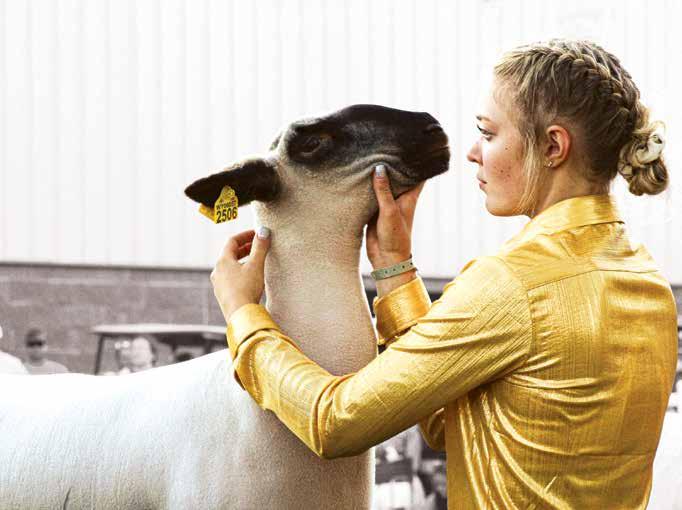
The Casper College rodeo team has a new head coach.
Faith Anders enters the position as the first female head coach in Thunderbird Rodeo history. She is joined by Assistant Coach Kris Newman.
Anders brings several years of competitive experience and two years of coaching experience within the National Intercollegiate Rodeo Association (NIRA) to the position.

Faith Anders Courtesy photo
About Anders Rodeo has long been a staple of Anders’ life. Originally from Kiowa, Colo., Anders grew up competing in high school rodeo and qualified for the National High School Finals Rodeo (NHSFR) three years in a row from 2015-17.
Anders continued competing throughout college, first at Northeastern Junior College (NJC) in Sterling, Colo. and then at the University of Wyoming (UW).
During her time at NJC, she earned the rodeo program’s Top Cowgirl Award in 2018 and 2019. Anders graduated from NJC with an Associate of Science in Sports Medicine
On Aug. 14, lifetime Hereford Breeder Dale Micheli of Fort Bridger received the Wyoming Hereford Legends Show Award during the Wyoming State Fair (WSF) in Douglas.
The award has been presented each year for the past six years by the Wyoming Hereford Association (WHA) to an individual who has dedicated time and effort to making significant contributions to the Hereford breed.
WHA Members Cindy and Gene Stillahn explained WHA members vote on the award recipient during their spring meeting, choosing individuals who have not only had an influence on Hereford cattle, but the tight-knit community of pure-

Competitors showcase talent during annual youth horse show
4-H and FFA youth from across the Cowboy State came together to showcase their talents during the annual Wyoming State Fair (WSF) Youth Horse Show, held Aug. 12 in Douglas.
Exhibitors across three age divisions competed in several events, testing their showmanship skills during in-hand halter classes, as well as their horsemanship skills across several performance competitions comprising Western and English disciplines.
Halter results
In the mare four years and younger category, Lindsey Thomas of Goshen County 4-H placed first, followed by Sydnee Vanderpool of Douglas FFA in second.
In the mare five years and older category, Carolina Navarro of Wright FFA came in first, while Miranda Smith of Niobrara County 4-H placed second.
In the gelding four years and younger class, Dani Martin of Goshen County 4-H ranked first, and Thomas earned another ribbon, placing second. In the gelding five years and older class, Merrilee Michael of Converse County 4-H reigned supreme, followed by Meredith Kennedy of Fremont County 4-H in second.
bred breeders as well.
“These award recipients are people who the younger generation of Hereford breeders have looked up to for advice and watched the way they run their successful operations to garner ideas on how to make their own ranches and cow herds better,” said Gene.
In an earlier interview with the Wyoming Livestock Roundup, Micheli noted his love for the breed began at a young age and was instilled in him by his grandfather Joseph Micheli, who purchased the family’s first Hereford cattle in 1917.
After fully taking over the operation, Micheli began to study pedigrees and work on adding dynamic females to the herd. He

The 2025 Wyoming State Fair (WSF) is over, and I’ll bet planning has started for 2026.
The Wyoming Livestock Roundup team is honored to be part of the WSF every year with the Roundup Tent. We were proud of the tent this year as it was the biggest one we ever had. We had 28 booths in the tent, and we were not crowded.
Thanks to the WSF for letting us put in a bigger tent, and thanks to the vendors who joined us, especially Farm Service Agency for bringing the popcorn.
Visiting with Del Tinsley, past publisher who started the tent at WSF, I figured the Roundup Tent had been at WSF for 44 years and started with two booths.
With this year’s hot temperatures, we provided a record 110 cases of ice-cold water. Thanks to Pepsi of Casper for donating the water and bringing it down.
The Wyoming Agriculture Hall of Fame Picnic, held each year on Wednesday evening, was great again with Juan Reyes, a rancher out of Wheatland, and Doug Miyamoto, director of the Wyoming Department of Agriculture, as the 2025 Wyoming Agriculture Hall of Fame inductees.
This Wyoming Agriculture Hall of Fame Award has been at the state fair since it was started by Tinsley some 33 years ago.
Throughout these years, there have been 76 Wyoming Agriculture Hall of Fame awardees. Wyoming agriculture is proud of Tinsley for having the foresight to initiate this award.
The award honors an individual or a couple who have dedicated their time and resources to promote and practice what is good for Wyoming agriculture.
Every year we announce opening for applications for the award until June 1. Around the first week of June, I appoint three judges – usually from the list of past awardees to select the winners that year.
The judges don’t know who the other judges are, and they are given a week to score the applications. They then send me the score sheets, which I add up and call to congratulate the winners. All of the applications we receive are eligible for three years.
We thank Sens. John Barrasso and Cynthia Lummis and Rep. Harriet Hageman (all R-WY), all of whom were home from Washington, D.C. on a much-earned break to travel around the state visiting with citizens.
We also thank Gov. Mark Gordon and First Lady Jennie Gordon for their remarks and for being a part of the presentation. The governor announced he and others are developing a strategic plan to highlight the importance of agriculture in the state.
There was also a presentation where Wyoming Agriculture in the Classroom awarded Neil Long of Lander the 2025 Educator of the Year Award.
Following the presentations was a barbecue dinner for all of the 220 attendees surrounded by a beautiful summer evening.
One can’t talk about the WSF and not recognize the dedication of those involved in putting it on – the board, staff and all of those who help during the week of state fair. It is an amazing group of people who have a hands-on approach to assuring everyone who attends has a great experience.

DENNIS SUN, Publisher • Cell: 307-262-6132
HANNAH
CURT COX, Director of Livestock Field Services • 307-630-4604 • curt@wylr.net
CALLI WILLIAMS, Livestock Field Services Rep. • 605-695-1990 • calli@wylr.net
By Sen. Cynthia Lummis
President Donald Trump’s One Big Beautiful Bill Act (OBBBA) delivers major victories to rural America and the West.
As the chairman of the Congressional Western Caucus, featuring 95 U.S. representatives, and the chair of the Senate Western Caucus, featuring 29 senators west of the Mississippi, we understand a stronger West means a stronger America.
The OBBBA is a giant step toward strengthening our country’s energy and food security and unleashing prosperity.
Over the last four years, the Biden administration waged war on the American West. By locking up lands and waters rich in energy and mineral resources as a handout to radical environmentalists, President Joe Biden weakened local economies across rural America.
Fortunately Trump, alongside House and Senate Republicans, understood the concerns of those who were most affected by these policies and crafted legislation to undo the damage.
This reconciliation package, signed by the president on July 4, unleashes domestic production of affordable and reliable energy sources.
The OBBBA expands onshore and offshore oil and gas leasing and increases offshore drilling revenue sharing in Gulf of America states, where 5.77 billion barrels of oil and 7.15 trillion cubic feet of gas remain in reserve.
Alaska, containing vast reserves of oil, gas and minerals, is a major winner in the bill, with six lease sales over the next 10 years mandated in the National Petroleum Reserve-Alaska and enhanced revenue sharing from Cook Inlet leases.
These provisions will create goodpaying jobs in resource-rich rural economies around the country, and increases in revenue sharing will fund priorities, such as education, in rural settlements.
Taken together, these policies will also lower gas prices and electricity costs for American families.
There are also major wins for land management and conservation efforts to combat the wildfire crisis, a priority of the Western Caucus.
In 2024, almost 65,000 fires burned 8,924,884 acres across the U.S. As peak wildfire season continues this year, the OBBBA expands timber sales on public lands.
Responsible timber harvests produce multiple benefits by removing hazardous fuels, which would otherwise fuel hotter and more dangerous wildfires that burn out of control. Combined with improved forest management policies, rural towns near public forests will be safer and more economically prosperous.
This legislation also strengthens American agriculture, putting farmers and ranchers first by shoring up the farm safety net.
Across the West, predators such as the gray wolf have stalked livestock,
leading to needless losses for ranchers until we get a delisting of the wolf. The OBBBA contains reimbursement programs for livestock lost to these attacks.
Additionally, the bill boosts the Livestock Forage Disaster Assistance program to aid farmers affected by grazing losses due to disasters such as wildfires or droughts and increases biosecurity measures.
Certain tax provisions also relieve burdens on the agricultural economy, in addition to individuals. Importantly, estate tax exemptions are permanently increased, easing the burden and removing uncertainty for family farms as they transfer from one generation to the next. An extension of immediate expensing allows deductions on critical equipment and infrastructure for farmers and ranchers.
After four years of policy failures from the Biden administration, the OBBBA delivers much-needed relief to rural economies across the West.
The Western Caucus has been proud to assist in passing this “America First” agenda. Now it’s time to see the results across the West.
Sen. Cynthia Lummis (R-WY) represents Wyoming in the U.S. Senate and serves as chair of the Senate Western Caucus. Rep. Doug LaMalfa (R-CA) represents California’s First Congressional District in the U.S. House and serves as the chair of the House Western Caucus. This opinion column was originally published in The Daily Signal on Aug. 13.

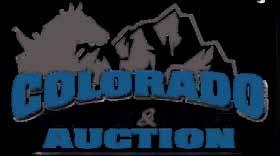
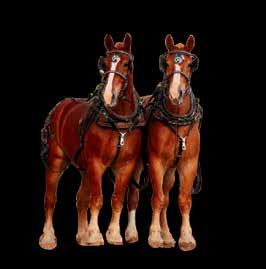


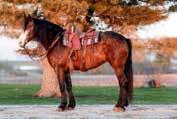

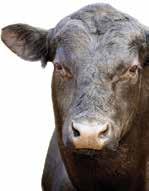

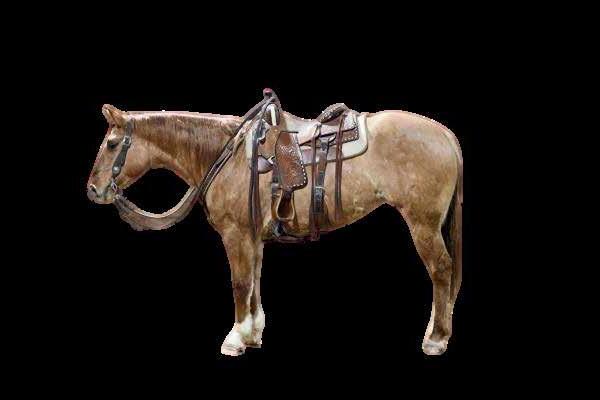


On Sept. 6, University of Wyoming Extension will lead the Homesteading Rendezvous, a unique event offering educational workshops for anyone interested in producing more goods at home – particularly food items.
The conference begins at 8 a.m. and ends at 4 p.m. It will take place at the Clay Pathfinder Building on the Laramie County Community College (LCCC) campus in Cheyenne.
The event will cover four broad subjects – livestock, food preservation, growing plants and canning. Participants may attend up to six workshops on topics from beekeeping to saving seeds.
A vendor fair featuring local businesses will take place throughout the event. Vendors will showcase kitchen supplies, food items and other products which may be used in homesteading activities.
A 13-foot-wide geodesic dome greenhouse valued at $2,500 will be disassembled and raffled off at the end of the event. To receive the geodome, the raffle winner must be present.
For more information, to view a full schedule of events or to register, visit bit.ly/homestead25. The cost is $30 for basic registration or $45 to attend a hands-on canning session. Lunch is included in the registration fee. Interested parties should pre-register for the event, as space is limited.
On Aug. 19, the Montana Stockgrowers Association (MSGA) filed an amicus brief alongside the Wyoming Stock Growers Association (WSGA) and Wyoming Wool Growers Association (WWGA) to the U.S. Supreme Court in a crucial corner crossing case.
The original litigation centered around four hunters who accessed checkerboarded public land via a ladder over the corner of private property.
The landowner – the plaintiff – sought to uphold the long-established principal in Wyoming which considered corner crossing to be a trespass. However, in March 2025, the 10th Circuit Court of Appeals upheld the right to corner cross to access federal public lands as long as a private landowner’s land is not physically touched.
The plaintiff has since filed a petition for the case to be elevated to the U.S. Supreme Court.
The filed amicus brief highlights the importance of a property owner’s right to protect their airspace and land from trespass.
WSGA Executive Vice President Jim Magagna noted, “WSGA has been engaged in this litigation since the case was initially filed in Federal District Court. It has been our position private property rights are appropriately under the jurisdiction of the state. Today, we are urging the Supreme Court to take up this case to provide a definitive answer to the trespass issue and to assure conformity in the law across the West. We are appreciative of WWGA and MSGA for joining us in this effort.”
Livestock producers in 34 counties in Montana, 19 in Wyoming, seven in North Dakota and six in South Dakota are eligible to apply for the Farm Service Agency’s (FSA) Livestock Forage Disaster Program (LFP).
LFP provides compensation to eligible livestock producers who suffered grazing losses for covered livestock due to drought on privately-owned or cash-leased land or fire on federally-managed land.
For LFP, qualifying drought intensity levels are determined using the U.S. Drought Monitor.
Eligible producers can apply for 2025 LFP benefits for grazing losses on small grains, native pasture, improved pasture mixed forage, annual ryegrass, crabgrass or forage sorghum.
FSA county offices can accept LFP applications following issuance of a disaster designation for drought and if a federal agency prohibits producers from grazing normal permitted livestock on federally-managed lands due to qualifying fire.
To date, the 19 counties in Wyoming which have triggered LFP assistance include Albany, Big Horn, Carbon, Converse, Fremont, Goshen, Hot Springs, Laramie, Lincoln, Natrona, Niobrara, Park, Platte, Sublette, Sweetwater, Teton, Uinta, Washakie and Weston.
To determine eligibility for LFP assistance, producers must complete form CCC-853 application and provide required supporting documentation for 2025 losses no later than March 2, 2026.
Livestock producers in qualifying counties may also be eligible for the Emergency Assistance for Livestock, Honeybees and Farm-Raised Fish Program. For more information, visit farmers.gov/drought
Bear spray giveaways and training events will be taking place throughout northwest Wyoming in late August and early September. The events will help raise awareness and provide important information about safety while recreating in bear country.
Training events will take place on at 10 a.m. on Aug. 30 at the Wyoming Game and Fish Department (WGFD) Cody Regional Office in Cody; 2 p.m. on Aug. 31 at the WGFD Lander Regional Office in Lander; 10 a.m. on Sept. 6 at the WGFD Pinedale Regional Office in Pinedale and 2 p.m. on Sept. 7 at the National Elk Refuge and Greater Yellowstone Visitor Center in Jackson.
Quantities are limited to 100 cans of bear spray at each event and will be available on a first come, first served basis. Participants will also receive training on how to use bear spray with “robo bear,” a remote-controlled mock charging bear which will simulate a sudden encounter situation.
Both WGFD and U.S. Forest Service biologists will be on site to discuss bear ecology and conservation and promote Bear Wise Wyoming guidelines.
For more information, contact Mark Aughton at 307527-7125.
The Wyoming State Geological Survey (WSGS) has completed a major initiative to preserve, modernize and publish its entire archive of uranium-related geologic data. The result is the Wyoming Uranium Resources Database, a powerful geospatial dataset which consolidates decades of exploration, mining and geologic information into a single digital platform.
This newly released geodatabase supersedes the widely used Uranium Map of Wyoming, last updated in 2010, and provides expanded functionality, searchable attributes and interactive capabilities.
The dataset is now available as both a downloadable geodatabase and as live layers within the WSGS’s online Mineral Resources Map.
The release comes at a pivotal time. According to the 2024 WSGS Uranium Summary, Wyoming has accounted for nearly 50 percent of domestic uranium production in recent years, and three in-situ recovery mines have restarted operations due to higher uranium prices and successful sales negotiations.
Facility upgrades, new wellfield development and exploration campaigns are now actively reshaping the landscape of Wyoming’s uranium sector.
For more information and to view the Wyoming Uranium Resources Database, visit wsgs.wyo.gov/
On Aug. 15, the Montana Department of Livestock (MDOL) received confirmation an animal from a Beaverhead County herd within Montana’s Designated Surveillance Area tested positive for brucellosis.
The herd has been placed under quarantine pending the completion of an epidemiological investigation.
The positive bull was identified as a brucellosis suspect during required testing at a livestock market in late July. The animal was euthanized and taken for necropsy at the Montana Veterinary Diagnostic Laboratory, where tissues were collected and sent to the U.S. Department of Agriculture’s National Veterinary Services Laboratory (NVSL) in Ames, Iowa for confirmatory testing. NVSL was able to grow the Brucella abortus organism from one of the lymph nodes collected from the animal.
The disease investigation will include testing and tracing of animal contacts and movements to ensure the disease is not present in other livestock herds. MDOL will work with the affected operation to minimize the impact of this diagnosis by conducting a tailored and focused investigation.
Each year, the Top Producer Summit honors the most innovative, resilient and forward-thinking farmers in the country.
At the Top Producer Summit, set for Feb. 9-11, 2026 in Nashville, Tenn., three distinct award categories will recognize producers who are innovating, leading and shaping the future of agriculture – all celebrated on one unforgettable stage.
The Top Producer Award recognizes producers at the forefront of agriculture, with one crowned overall winner. The Next Gen Award is for producers 40 and under who are building smart, scalable and innovative operations. The Women in Ag Award celebrates female leaders growing a successful business and empowering others in agriculture.
Finalists win an expenses-paid trip for two to the Top Producer Summit. Winners will also receive additional prizes provided by event sponsors.
The deadline to apply for the awards is Sept. 1.
For more information and to apply, visit events. farmjournal.com/top-producer-summit-2026/ top-producer-awards?utm_campaign=15784609Top%20Producer%20Summit%202026&utm_ medium=email&_hsenc=p2ANqtz--tvwh3RyearopD-du-Ldx9CW3QR9cilunx7DoCuBz3v1k Y4HdW_7M_OEWj9C1NuHAqae1iaMGpBSZvNZxbJZz0aeen9A&_hsmi=375594447&utm_ content=375594447&utm_source=hs_email


Kenneth “Kenny” Charles Haas peacefully passed away on Aug. 16 at home with his family. Cremation has taken place.
Kenny was born in Torrington on Sept. 25, 1950 to Lora Mae (McIntosh) and Hubert L. Haas. He was the fifth of seven children and the youngest son.
Kenny was raised in the Veteran community and graduated as a Goshen Hole Spartan in 1969. After high school, he judged livestock at Casper College and received a degree in animal science from the University of Wyoming.
Sports encompassed his youth, and Kenny excelled as an all-state athlete in baseball, football, basketball and track. He was proud to follow his children and grandchildren through their sporting endeavors.
In October 1973, he married Charlene Boner of Lusk. They had two sons – Kirk Charles and Kevin Jordon. The family home was on the Boner Ranch north of Lusk. Charlene later moved to Laramie and Kenny remained on the ranch.
At the Wyoming State Fair (WSF), Kenny met
Heather Braman. They were married in August 2001. To this union was born Kendall Christine.
Kenny’s legacy was his three children and grandchildren. His greatest joy was seeing them in the showring, showcasing cattle with the KC brand. There were many rosettes, banners, buckles, trophies and memories collected over the years.
The Haas family was rooted in agriculture, and Kenny’s love of livestock started in childhood with bum lambs, quickly moving to Angus cattle. Kenny’s grandfather George F. Haas was credited with bringing the first registered Angus cattle into Wyoming with the purchase of a bull in 1935. Angus cattle were his heritage.
Beginning in the fall of 1973, Kenny owned and

operated a custom cattle fitting service. He was a partner in a registered Angus business with his brother Bill. In 1976, Kenny moved his part of the operation to the Boner Ranch, and Kenny and Charlene continued to grow the herd.
In 1983, the family held the first annual Right Combination Bull Sale, then Kenny relocated the herd to the current place in LaGrange in 1985.
There have been several improvements made to the place, including a sale barn where Kenny has held the annual production sale for the past 25 years.
Kenny and Heather were devoted to raising the right combination cattle with high carcass genetics, longevity, strong fertility and maternal traits.
Kenny belonged to 4-H, FFA, the Wyoming Angus
Wt Stop: 25 lbs. Located: Cunningham, KS. Delivery: 9/1/25 to 9/15/25. Origin: Purchased from KS, MS, OK. Feed: Native Grass. Shots: Pyramid 5+Presponse, Vision 7/Somnus, Inforce 3, Synanthic Wormer, Revalor G Implants. Weigh: Early am gather, sort for loads, weigh on buyer’s pre-weighed trucks w/a 2%. Comments: Nice set of green steers. Could go back to grass or green chop. Option on next lot. Rep: Jeff Ward 307-399-9863. Lot 8401 Carpenter Cattle 400 Yearling Steers. 85% Blk/Bwf; 12% Red/Rwf; 3% Char. Base Wt: 750 lbs.. 2-way Slide: .16. Wt Stop: 25 lbs. Located: Manhattan, KS. Delivery: 9/1/25 to 9/15/25. Origin: Purchased from KS, MS, OK. Feed: Native Grass. Shots: Pyramid 5+Presponse, Vision 7/Somnus, Inforce 3, Synanthic Wormer, Revalor G Implants. Weigh: Early am gather, sort for loads, weigh on buyer’s pre-weighed trucks w/a 2%. Comments: Nice set of green steers. Could go back to grass or green chop. Rep: Jeff Ward 307-399-9863.
Lot 8402 Carpenter Cattle 400 Yearling Steers. 99% Blk/Bwf; 1% Red/Rwf. Base Wt: 850 lbs.. 2-way Slide: .16. Wt Stop: 25 lbs. Located: Cunningham, KS. Delivery: 9/1/25 to 9/15/25. Origin: Purchased from WY & MT. Feed: Native Grass. Shots: Pyramid 5+Presponse, Vision 7/Somnus, Inforce 3, Synanthic Wormer, Revalor G Implants. Weigh: Early am gather, sort for loads, weigh on buyer’s pre-weighed trucks w/a 2%. Comments: Nice set of northern black steers. Rep: Jeff Ward 307-3999863. www.cattlecountryvideo.com
FEEDERS
Stan Swanson 95 Blk Strs, 850#, Complete Vac. Program, No Implants, Been on a Complete Mineral Program, Coming off grass, Home Raised, Sired by Lucky 7 Blk Angus Bulls ****47 Blk Hfrs, 750#, Guaranteed Open, Complete Vac. Program, No Implants, Been on a Complete Mineral Program, Coming off grass, Home Raised, Sired by Lucky 7 Blk Angus Bulls Nottingham Ranch 82 Blk Hfrs, 900#, PTO on Aug. 7 coming off their Replacements, Complete Vac. Program, Home Raised, High Elevation 88 Ranch Land & Livestock 80 Blk Hfrs, 900#, PTO @ ranch on Aug. 26 by Dr. Smiley, Complete Vac. Program, Coming off grass, Home Raised
Justin Miller 60 Mx Hfrs, 800-900#, PTO @ ranch, Complete Vac. Program, Coming off grass, 1-iron, Home Raised Nelson & Hodge 60 Mx Hfrs, 800-900#, PTO @ ranch, Complete Vac. Program, Coming off grass, 1-iron, Home Raised Alan Harrison 50 Blk Strs & Hfrs, 800-850#, Heifers are Spayed, Branding Shots, No Implants, Coming off grass, Producer All Natural Roaring Fork Cattle Co. 30 Blk Hfrs, 900#, PTO @ ranch on Aug. 26, Complete Vac. Program, Coming off grass 7 U Ranch/Lonnie Frimann 16 Red/Blk Strs, 800#, Complete Vac. Program, Coming off grass
Association and the American Angus Association. In 1982, he made the “Who’s Who in the Western Livestock Industry” – a collection of biographies of the leaders in the industry.
Kenny’s favorite time of the year was fair time, especially the WSF. He loved apple pie, Schwans ice cream, Hershey’s kisses and a good, certified Angus steak.
Kenny is preceded in death by his parents Hubert and Lora Mae Haas, brother Bill Haas, brother-in-law Bill Ward, nephew Crocket Herring and father-in-laws Mike Braman and Bob Mukenschnabl.
Kenny is survived by his wife Heather; children Kirk (Stephanie) of LaGrange, Kevin (Jamie) of Crawford, Neb. and Kendall of LaGrange; grandchildren Dr. Chloe (Eber) Mendez
of Bloomfield, N.M., Luke of LaGrange and Liam of LaGrange; great-granddaughter Nora Eden Mendez; siblings Marilyn (Pat) Herring, George Haas, Carolyn Ward, Jackie (Kevin) Nickel and Sherry (Dan) Espeland; sister-in-law Dana Haas; mother-in-law Cindy Mukenschnabl; in-laws Ward Braman, Ryan (Amy) Braman and Anna Callahan, as well as numerous nieces, nephews, cousins and dear friends.
Memorial services will be held at 1 p.m. on Sept. 15 at the Rendezvous Center on the Goshen County Fairgrounds with Pastor Todd Busenitz officiating. In lieu of flowers, donations may be made to LaGrange Volunteer Fire Department or Ken Haas Memorial. Funds will go toward youth Angus organizations.
The fate of an antitrust lawsuit filed by two South Dakota ranchers against major meatpackers, alleging they are labeling beef products as “Products of the USA” when most of the meat is not produced in the U.S., will be decided by a federal appeals court.
Ranchers Tim Taylor and Bryce Baker filed a class-action lawsuit in 2023 alleging the labeling practices of JBS Foods USA; Tyson Foods, Inc.; Cargill Meat Solutions Corp. and National Beef Packing Company LLC have cost ranchers across the country billions of dollars in lost revenue annually since 2015.
The producers originally filed their case in state court, and it was later moved to the U.S. District Court for the District of South Dakota. In January 2025, the court denied the companies’ motion to dismiss, and the companies appealed to the U.S. Appeals Court for the Eighth Circuit to try to end the case.
This week, attorneys general in South Dakota, Nebraska, Idaho, North Dakota, Colorado, New Mexico, Texas, Montana, Kansas, Oklahoma and Wyoming filed an amicus brief in support of the ranchers.
The states told the Eighth Circuit they have an economic interest in the outcome, as they “raise, process and ship to market a large share of the domestic beef products consumed in this country.”
On Aug. 21, U.S. Secretary of Agriculture Brooke Rollins announced Laurie Boner has been appointed as the new state executive director (SED) for the U.S. Department of Agriculture’s Farm Service Agency (FSA) in Wyoming.
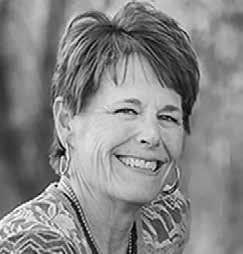
Boner is a rancher and small business owner residing near Glenrock. She is actively involved and serves on numerous agriculture-related boards. Previously, she had a successful career with the Wyoming Department of Agriculture for over 15 years, where she oversaw the state’s food safety and environmental health program.
Her work on the Wyoming Stock Growers Association, Converse County Stock Growers, Converse County Tourism, Wyoming Sheep Foundation, Wyoming State Fair and Wyoming Stock Growers Land Trust boards showcases her relentless commitment to agriculture and community.

A University of Wyoming graduate, Boner also served on the Wyoming Quarter Horse Association board and served six years on the Wyoming Livestock Board.
In 2021, Boner was honored as the Heart of Agriculture Award winner and then in 2024 was inducted into the Wyoming Agriculture Hall of Fame. She is also a graduate from the Wyoming Ag Leadership Education and Development Program.
As SED, Boner is responsible for overseeing the delivery of FSA programs to agricultural producers in Wyoming.

By Amy Smith, UW Extension Educator

Canada thistle, Cirsium arvense L., is an introduced, creeping perennial native to southeastern Europe and the Mediterranean region. It was introduced to North America between the 17th and 19th centuries by contamination of ship ballast.
Since its introduction, Canada thistle has adapted to a wide range of habitats including abandoned sites, ditches, crops, pastures, rangeland and roadsides, as well as non-crop areas.
An established Canada thistle population will displace native plant species, reduce pasture and rangeland quality and reduce crop yields. Significant Canada thistle populations will decrease productivity of pastures and rangelands as livestock will actively avoid grazing around the spiny foliage and may cause cuts or abrasions leading to active infections.
Canada thistle may cause additional economic damage by playing host to agricultural insect pests and diseases such as the sodweb worm, bean aphid, stalk borer and cucumber mosaic virus.
Description
Canada thistle is a spiny, creeping perennial forb. Its erect stems reach an average height of two to five feet tall, which are often smooth – spineless – or may have shallow lengthwise lines.
The stems die back each winter and new shoots form from established basal roots.
Canada thistle has an extensive fibrous root system which will spread laterally 12 to 18 feet and can reach depths of six to 15 feet, making control difficult.
The plant has dark green, alternate lobed leaves six to eight inches long and approximately one to 1.5 inches wide.
Emergence, reproduction and spread
Plant flowering is stimulated by 14- to 16-hour

days and produces purple, pink- or white-colored flower clusters found at the end of stems and branches from May through August.
Canada thistles grow in circular patches – usually clones or plants of a single sex – meaning male and females flowers grow on separate plants.
The female plants produce a sweet smell, attracting insects which will pollinate separate male and female patches up to 200 feet apart.
Each branch can produce 1,000 to 1,500 small tan to dark brown seeds.
The seeds – called achenes – have an apparatus called a pappus, which is a tuft of hair aiding in seed dispersal.
Canada thistle seeds utilize a variety of successful dispersal methods such as wind, water, livestock, wildlife, equipment or humans, and it has a very high germination rate. The seeds held within the soil profile can be viable for 20 to 22 years.
The plants use seed production to colonize new locations, whereas asexual reproduction is used to continually grow in its current location. Given the opportunity, Canada thistle will reproduce asexually by rhizomes – modified stems which grow horizontally underground – rather than by seed, as it requires less plant energy.
Regardless of the reproductive method, both pathways produce new rosettes in mid- to late-spring, with the potential of a second germination and/or growth period in fall with adequate moisture.
Seeds found within the top three inches of the soil can germinate, grow and reproduce asexually seven to eight weeks after initial germination, thus causing significant management issues.
Habitat
Canada thistle is found on all continents except for
Antarctica. It thrives in all habitats.
However, it is quick to establish in disturbed locations and is known to colonize crops, pastures, rangelands, roadsides, ditches, canal banks, riparian areas, forests, gardens and lawns.
Canada thistle will also invade healthy, undisturbed locations, outcompeting or displacing desirable forbs and grasses using allelopathic chemicals. Allelopathy is when a plant exudes a self-produced chemical which inhibits the growth of neighboring plants, resulting in lower biodiversity, forage production or crop yields.
The Wyoming Weed and Pest Council lists Canada thistle as a statewide noxious weed, indicating the negative impact of Canada thistle found across the state.
Although prevention is the best management tool, maintaining a healthy pasture and rangeland environment including diverse grass and forb species, as well as utilizing appropriate stocking and grazing techniques for livestock will reduce the likelihood Canada thistle will become established.
Prevention should be the goal to reduce establishment of any new weed, noxious or not.
Early Detection and Rapid Response is a process used to identify newly invasive species prior to or right as establishment occurs when the species is easily controlled or eradicated.
Actively scouting, monitoring and identifying new species are key factors which should be in all management plans, as most invasive species become established quickly, including Canada thistle.
As with most problematic species, an Integrated Pest Management approach is best, as it utilizes multiple control strategies, reducing the potential for resistance.
Canada thistle is adept at overcoming control methods because of its extensive root system. Therefore, one key strategy is to simply stress the plant, forcing it to use nutrient reserves stored in the roots.
Control of an established Canada thistle patch is a long, slow process

which may require multiple years before full control is achieved.
Mechanical control
Mowing established Canada thistle patches can be an effective measure to reduce seed production when completed prior to flowering and repeated monthly for multiple growing seasons.
However, mowing combined with herbicide applications is a more effective control strategy.
The mowing and herbicide combination is successful as the plants utilize stored nutrients for growth of new shoots after each application.
Cultural control
Neither grazing nor prescribed burns have shown to be an effective control of Canada thistle.
Although, when used in combination with other control methods, these may provide a level of control.
Biological control
There are biological measures available for controlling Canada thistle. However, when biological control agents are used to control plant species, they will not completely control or eradicate the population.
When biological measures are used as a part of an integrated approach, it may reduce population growth and/or spread.
Puccinia punctiformis –thistle rust – is a rust fungus
specific to Canada thistle which lives inside the plant roots. Infected plants will have dark red colored pustules on the stem and leaves leading to stunted growth and necrosis of plant tissue, eventually killing the plant.
P. punctiformis does not spread far. Therefore, total control is limited.
Canada thistle stem weevil, Ceutorhynchus litura, is approximately four millimeters long and have long snouts. They feed on young plant tissue as it elongates. C. litura itself does not cause significant damage, although it allows entry points for secondary pathogens resulting in additional plant damage.
Urophora cardui – or Canada thistle stem gall fly larvae – cause damage by burrowing into the thistle stem, causing galls to form, which redirect nutrients away from the rest of the plant. Plants with galls have shown to produce less seeds and are less competitive than healthy plants.
Chemical control
When using chemical control options, always read and follow all product label directions and use precautions for specific treatment locations.
Products containing the active ingredients glyphosate – non-selective – chlorsulfuron, clopyralid, aminopyralid, metsulfuron, triclopyr, dicamba, 2,4-D and
picloram – restricted use –have shown to effectively control Canada thistle.
Several of the chemicals listed may be tank mixed for increased control. Always read chemical labels for instructions on compatibility before mixing compounds.
For complete control of Canada thistle, spring and fall applications may be needed. For fall treatments, it is best to make chemical applications after a light freeze. Applications may be needed for multiple seasons before the nutrient reserves and seeds found in the soil are depleted.
For help identifying Canada thistle or to discuss management options, contact a University of Wyoming (UW) County Extension Office or county Weed and Pest office.
Trade or brand names used in this publication are used only for the purpose of educational information. The information given herein is supplied with the understanding no discrimination is intended and no endorsement information of products by UW Wyoming Extension is implied. Nor does it imply approval of products to the exclusion of others, which may also be suitable.
Amy Smith is a UW Agriculture and Natural Resources Extension educator. She can be reached at asmit207@uwyo.edu.
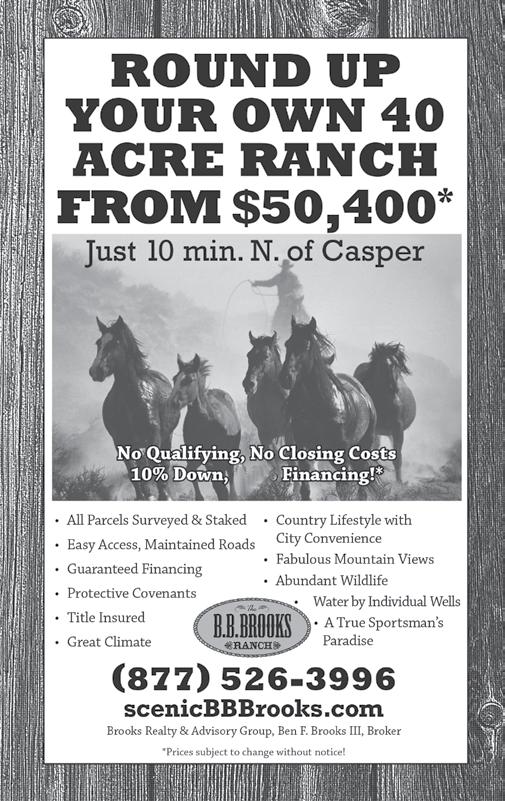
$63,900* 6.9%
As swathers, haybines and balers hit the fields, storing forages is on the minds of many beef cattle producers. Proper hay storage is essential to preserve resources produced in summer months and provide high-quality winter feed for livestock when grazing is not feasible or accessible.
Preparation done ahead of time can help avoid quality and quantity losses when harvested forages are exposed to the weather.
A six-foot diameter round bale stored uncovered can be expected to have spoilage in a four-inch layer around the outside of the bale, which represents 20 percent of the bale volume.
Given feed is the major input cost in cattle production, producers must evaluate the cost of production for all stored hay systems to determine which one best
fits their operation and goals.
Considerations
Minimize storage losses due to heating and mold growth by baling at moisture levels between 15 and 18 percent.
Increased bale density enhances the ability of round bales to shed water. Even, uniform windrows make formation of consistently shaped and dense bales easier.
The external layer of a bale represents a substantial loss of yield and quality due to weathering. Bale size impacts the proportion of hay in the surface layer with larger bales having less percentage of their total feed exposed.
Choose well-drained storage sites. Regardless of the method of storage, bales will pull moisture up from the ground through a “wicking” action. Therefore, choosing well-drained sites
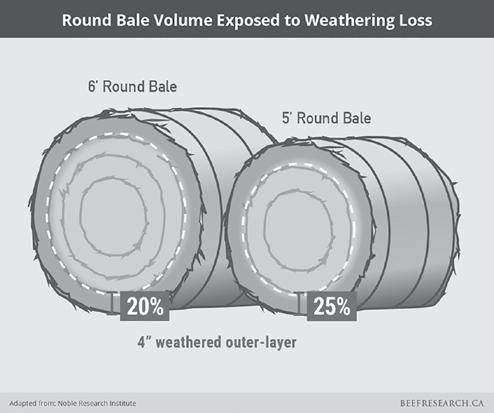
for storage locations can help prevent this.
Large round bales without cover should be stored end-to-end in single rows in a north-south orientation. Include space between the bales to facilitate good air circulation and drying.
Storage losses can be
reduced by two-thirds with indoor storage and by onehalf with good covering outside.
Conclusion
Hay storage is important to preserve forage quality and to provide cattle with the essential nutrients required to keep them healthy and the
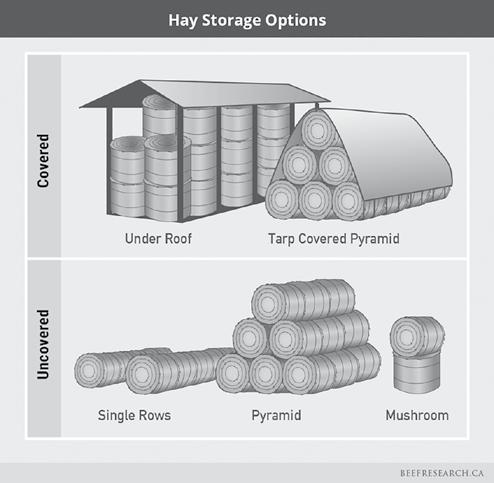
operation running smoothly.
All farms are different, and no storage system is one size fits all so producers should find the option that works best for them.
The Beef Cattle Research
Council (BCRC) strives for excellence in the production of Canadian beef and forage through research, innovation and Extension. For more information, visit beefresearch.ca
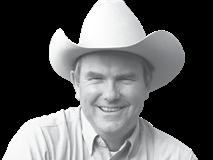

In this column, I’m going to reveal a secret that may destroy my career as a cow columnist. It’s so bad, my fellow cowboy friends may boot me from their ranks. My wife says I should just hobble my lip and never reveal my secret, but I think I’m being dishonest in not leveling with you.
So here goes.
I can’t eat the beef I raised. Just can’t do it. No, I’m not a vegetarian or a vegan, and I’ve never eaten a Beyond Beef burger or a fake piece of Impossible
by Lee Pitts
beef. No cheeseburgers without beef for me.
Here’s the thing – I could always eat lambs and hogs I raised. In fact, I quite liked them. One of my biggest projects in FFA was raising cute little white bunny rabbits for meat, and I had no trouble whacking them on the neck. I found them to be quite tasty. I’m not kept awake at night by nightmares of those bunnies looking at me with their cute little pink eyes. In FFA I raised a couple Mallard ducks I named
Chester and Charley. I know the old adage says you’re not supposed to name an animal you intend to eat, but those two ducks were the best comedians in the barnyard and they gave me many hours of enjoyment just watching them.
A smile comes to my face even now when I think of them, and yet, I had no trouble gobbling them down. Let me tell you, beef is the only thing better than duck with a little orange sauce.
I hate to admit this, but we also raised a lot of chickens – both for their meat and for their eggs –but this isn’t the big admission I mentioned at the start of this column.
I gagged down the tough hens, but I refused to eat their eggs. To this day, if I see someone break the yellow yoke of an egg and
mix it with perfectly good potatoes, ham and pancakes, it’s enough to make me spew.
I’ve gobbled down trout I caught and had no trouble eating anything I hunted, but I do admit I don’t relish eating deer meat. It’s not because I melt like a snowflake when I gaze into a deer’s sad eyes, it’s just that I don’t care for venison.
To me, it’s almost as bad as eating liver, which is the single worst-tasting thing I’ve ever eaten in my life, except for lima beans. Yuck!
As a kid I was raised on one acre of ground which I transformed into a huge garden. While I’m not a big fan of radishes, beets and turnips, I didn’t hear them scream when I jerked them from the ground. And I don’t dis-
like every tuber because I absolutely love potatoes.
To this day, I still have a wonderful taste left in my mouth by home-grown sweet corn, cantaloupe, broccoli and green beans. There’s no better refresher in the world than homeraised cold tomatoes with salt on them.
Yet, I couldn’t eat any of the steers I raised, and I absolutely love beef. Even as a rancher later in life I much preferred my neighbor’s beef to that of my own, and I think there’s something wrong with me psychologically since I can’t enjoy beef from cattle I raised.
Is it just because I’m a big old pansy or is there something mentally wrong with me? Could I be crazy?
I decided to seek professional help. I’ve never understood the differ-
$2 million
appropriation from the Wyoming Legislature. The grant program allows communi-
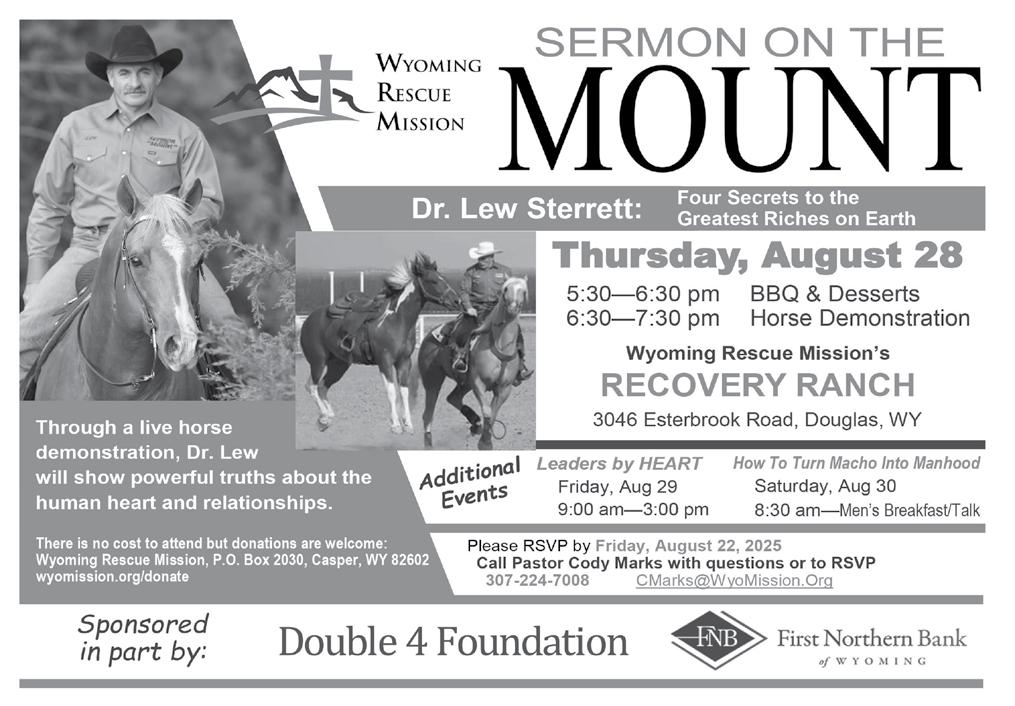
ties to recognize and celebrate Wyoming’s unique role in American history and to explore both Wyoming’s lasting legacy and future potential.
The projects will take place in conjunction with the celebration of the 250th Anniversary of the Declaration of Independence in 2026.
Four counties and two statewide entities were awarded grants totaling $66,600.
They include the Albany County Historic Preservation Board, which will create an internship position to support the planning and implementation of America250 events across Albany County; the Big Horn County Remember, Honor and Preserve 2026 Project which aims to preserve and permanently protect two Civil War cannons, promoting long-term public access and education and the Arts for All Wyoming 250 Grant Program, in which Teton County Arts for All will create and administer a
ence between a psychologist and a psychiatrist, but I took advantage of the fact a psychologist moved close by.
One day I casually asked her about my beefeating problem, but she said she was not the one to ask as this was beyond her realm of study.
“But, based on what I’ve observed just watching you from afar and now hearing this about you, my professional opinion is yes, you are nuttier than a wood rat and belong in an insane asylum,” she said. “And not just because you can’t eat your own beef. But just to be sure, I think you should see a psychiatrist.”
“But what’s the difference between a psychiatrist and a psychologist?” I asked.
“About $150 an hour,” she replied.
one-time grant program for art and education projects which embody America250. Other awardees include Celebrating Uinta County for 250 Years and Beyond, where Uinta County will implement a community driven project to build a bison metalwork sculpture reflective of the county’s rich history; Reflecting America: Past, Present and Future, in which the Wyoming Arts Council, in collaboration with the Wyoming Secondary Art Education Association and the Wyoming State Museum, will create a new category for the Wyoming State Art Symposium, encouraging students to create works that celebrate America250 and Wyoming Veterans In Focus: Oral History and Photo Exhibit, in which the Wyoming State Parks and Cultural Resources will initiate an oral history and photo exhibit of Veterans’ experiences and lives in Wyoming, to be showcased at the Wyoming Territorial Prison and preserved in the Wyoming State Archives.
The 2025 Wyoming State Fair (WSF) small animal shows offered 4-H and FFA youth from across the Cowboy State the opportunity to display small animal projects in the dog, cat, poultry and rabbit shows held throughout the week.
Results from the poultry and rabbit shows have been posted to the WSF website.
The poultry show was held Aug. 14 in the Event Tent. Youth exhibited several varieties of geese, ducks, turkeys and chickens during the event and participated in showmanship classes to showcase knowledge of their respective projects.
The rabbit show was held Aug. 15 in the Event Tent. In addition to show-
manship contests, several Grand Champion, Best of Breed and Best of Show ribbons were awarded to youth projects spanning several categories from domestic to foreign breeds and multiple classes of meat, fur and wool divisions.
For detailed small animal show results, visit wystatefair.com/exhibitorresults/
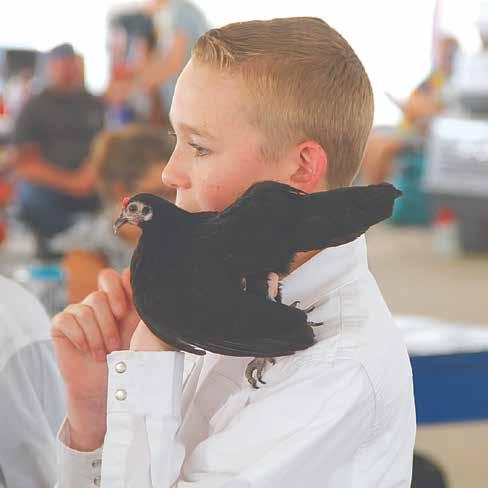
before continuing her education at UW.
Anders rodeoed for UW for four years, serving as the rodeo team captain from 2022-23 and qualifying for the College National Finals Rodeo (CNFR) three years in a row while working towards a Bachelor of Science in Kinesiology and Health Promotion.
Throughout her college career, Anders served as the NIRA Central Rocky Mountain Region student director from 2021-23, in
addition to earning AllAround Cowgirl and goat tying regional championship titles in 2021. Coaching background
On the coaching side, Anders says she first learned the importance of pouring into other people from her father Dave Hoffman who coached college rodeo at the U.S. Air Force Academy for a few years throughout Anders’ childhood.
She credits Hoffman as a shining example of the importance of “pouring
into the next generation” by sharing knowledge and providing support both in and out of the arena.
Anders discovered her own talent and passion for coaching in late high school, giving lessons at clinics and camps.
“Since then, it’s just blossomed,” Anders says. “God has put opportunities in my life to continue coaching. He just keeps opening doors.”
In 2023, Anders took an assistant coaching position with the Missouri Valley College Rodeo Team in Marshall, Mo. Under

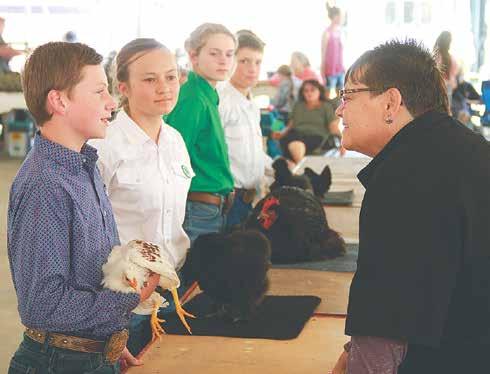

the leadership of Anders and Head Coach Ken Mason, the Missouri Valley Vikings finished as the reserve champion overall team at the 2025 CNFR.
“My time at Missouri Valley taught me learning about the students’ goals is most important,” Anders says. “I can have my goals for the team as a coach, but it boils down to them. We want to help them and give them the tools and opportunities to be successful.”
“It’s about as much fun – if not more fun – to see those you’ve helped win than it is to win yourself,”
Anders says. Casper College rodeo The Casper College Thunderbirds are consistently strong competitors across the college rodeo circuit.
In June, Casper College sent seven cowboys to the 2025 CNFR. The men’s team finished fourth in the nation, with T-Bird James Perrin of Maple Creek, Saskatchewan, Canada sweeping the competition to bring home a national title in the saddle bronc riding.
Under the leadership of Anders and Newman,
a standard of excellence which has long marked Casper College Rodeo is sure to continue. The fall season kicks off Sept. 5-7 at Chadron State College in Chadron, Neb. The rest of the fall schedule includes Central Wyoming College Sept. 19-21, Sheridan College Sept. 26-28, Lamar Community College Oct. 3-5 and Laramie County Community College Oct. 10-12. Grace Skavdahl is the editor of the Wyoming Livestock Roundup. Send comments on this article to roundup@wylr.net.








Livestock judgers representing 4-H chapters from across the state of Wyoming recently competed at the Wyoming State 4-H Livestock Judging Contest, held Aug. 12 in Douglas during the Wyoming State Fair.
After sorting through a series of goats, sheep, cattle and hogs and defending their rankings with verbal reasons, the top-scoring contestants across three age divisions were recognized with awards. Individual and team honors were presented to top-placing livestock judgers in the junior, intermediate and senior divisions.
In the junior individual division, Lacy Anderson of Fremont 4-H took first overall with a score of 551. Oakley Bekken of Fremont 4-H finished second with a score of 546 points, followed by Sammy Boardman of Big-
horn 4-H in third with 524 points.
The top three teams in the junior division were Fremont 4-H, Bighorn 4-H and Washakie 4-H. The winning Fremont 4-H team was composed of Lacy Anderson and Oakley Bekken, who scored 551 and 546 respectively for a combined team score of 1,097 points.
In the intermediate individual division, Kye Thompson of Albany 4-H placed first overall with a score of 584 points. Wynn West of Sheridan 4-H placed second with 566 points, followed by Jansen Hornecker of Natrona 4-H in third with 562 points.
In the intermediate team division, the top-performing teams were Natrona County 4-H, Sheridan 4-H and Fremont 4-H. The winning Natrona County 4-H team
was made up of Jansen Hornecker, Wace Kammerer, Grayden Burkett and Hannah Williams who brought in a total combined score of 1,604 points.
In the senior individual division, Blair Sanchez of Laramie County 4-H took first overall with a score of 582 points. Garrett Burkett of Natrona County 4-H placed second with a score of 579 points, followed by Kaleb Booth of Goshen County 4-H with 576 points.
In the senior team division, Albany County 4-H came out on top, followed by Sheridan County 4-H and Laramie County 4-H.
Albany County 4-H teammates Riley Lake, Jadyn Lake, Shanna Stinson and Caden Miller put together a combined score of 1,687 points to clinch their first-place finish.

For full results from the Wyoming State 4-H Livestock Judging Contest, visit judgingcard.com/Results/Events.aspx?ID= 26017.

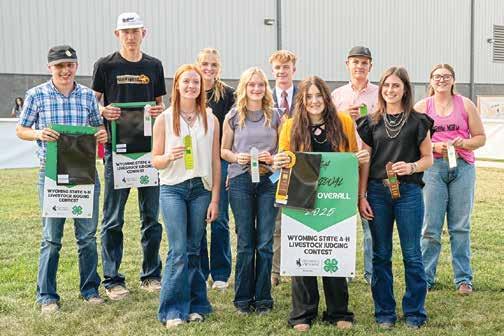

Thank you to the sponsors of the Wyoming Agriculture Hall of Fame Picnic!




Thank you to everyone for making the 2025 Ag Hall of Fame Awards a success!
We appreciate everyone who submitted nominations, attended the picnic and congratulations to the 2025 awardees, Doug Miyamoto and Juan Reyes.
Overall Grand Champion accolades were awarded to Michael and Navarro, while Thomas earned reserve champion overall honors.
Senior performance results
Thomas picked up several more first-place finishes in the senior performance events, earning top scores in the hunter under saddle, hunt seat equitation, Western pleasure, Western horsemanship, ranch riding, trail and reining competitions, in addition to placing second in the senior Western riding and working cow horse.
Kaitlyn Snyder of Campbell County 4-H earned firstplace ribbons in hunter hack, Western riding and working cow horse, as well as second place in hunt seat equitation, Western pleasure, ranch rid-
ing and reining.
Taebyn McGinley of Campbell County 4-H earned second-place ribbons in the hunter hack and trail divisions.
Teeka Baker of Sheridan County 4-H took second in the Western horsemanship division, and Taylor Hernandez of Green River FFA took second in the hunter under saddle competition.
In the barrel racing, Izabelle Pedri of Sweetwater County 4-H took first place, followed by Shae Smith of Albany County 4-H. Smith earned another second-place finish in the pole bending, while first place went to Cheznee Mackey of Uinta County 4-H.
In the goat tying, Paisley Chadwell of Platte County 4-H earned first place, followed by Royal Kremers of Niobrara County 4-H.
Every year during the Wyoming State Fair (WSF), the Miss Rodeo Wyoming (MRW) pageant hosts rodeo queens from across the Cowboy State who compete for the title of Miss Rodeo Wyoming. The winner of this year’s pageant was Kate Budge.
MRW contestants are evaluated across horsemanship, personality and appearance categories by a panel of judges.

According to the official MRW website, “MRW is the ideal, agriculturally-oriented American young woman, who embodies professionalism, speaks intelligently and has integrity, good character, knowledge and grace.”
Duties of MRW include promoting agriculture, professional rodeo and the Western way of life throughout extensive travel and appearances across Wyoming and the nation.
The 2026 MRW Pageant began on Aug. 11 and concluded with Budge’s crowning on Aug. 14.
Budge is the 20-year-old daughter of Joey and Nicole Budge. A seventh-generation Jackson Hole native, she competed in the MRW pageant as the 2025 Teton County Fair and Rodeo Queen.
Budge’s passion for rodeo began early. She is an accomplished horseman and has earned many accolades in barrel racing and goat tying, as well as reined cowhorse and cutting competitions, throughout her life.
Budge showed horses during her 11 years as a 4-H member, in addition to market beef and sewing projects. During this time, she was honored with the Cody Shervin Memorial Award – one of Teton County’s highest recognitions for leadership and integrity.
Budge maintained a 4.0 GPA during her time at Laramie County Community College (LCCC) while competing on the college’s Ranch Horse Team. She holds an Associate of Science in Business and Accounting from LCCC and plans to pursue a double major in business economics and finance at the University of Wyoming this fall.
Budge’s platform “Long Live Cowgirls” addresses the leading cause of death for Wyoming Women – cardiovascular incidents. In partnership with the American Heart Association, Budge promotes CPR education and has helped teach the basics to more than 100 Wyoming FFA members.
Budge’s reign as MRW is set to commence on Jan. 1, 2026. She succeeds MRW 2025 Dusty Miller.
Intermediate performance results
Will Kruse of Niobrara County 4-H collected several top finishes in the intermediate performance horse events, including first place in ranch riding and box drive and second place in the reining and trail classes.
Kendra Bauder of Platte County 4-H placed first in Western pleasure and Western riding, as well as second in hunt seat equitation and ranch riding. Fellow Platte County 4-H’er Tra Bauder placed second in hunter hack and Western riding.
Lexi Free of Teton County 4-H took first in the hunt seat equitation and hunter hack contests, as well as second in hunter under saddle and Western horsemanship.
Mikah Raley of Sheridan County 4-H collected first place in the hunter under saddle and Western horsemanship contests.
invested in prominent sires and started utilizing artificial insemination and embryo transfer to build a high-quality, renowned purebred herd.
In addition to running his highly-successful operation in the heart of Uinta County, Micheli has remained an active and integral force in promoting the Hereford industry across the state of Wyoming and the nation as a whole.
He has served on the American Hereford Association Board of Directors and Certified Hereford Beef. He has hosted Hereford Field Days on the Micheli Ranch in
Michael placed second in the Western pleasure division, and Deklan McGinley of Campbell County 4-H earned first place in the trail competition.
In the barrel racing, Claire Jackson of Campbell County 4-H took first, followed by Teagin Savage of Laramie County 4-H.
In the pole bending, Elizabeth Severude of Shoshoni FFA placed first, followed by Quinn Schneider of Laramie County 4-H.
In the goat tying, Teigen Derner participated for Laramie County 4-H and Burns FFA to take both first and second places. Derner also earned second place in the box drive competition.
Junior performance results
Natalie Sampers of Nio-
Fort Bridger, helped enhance the Hereford Show at WSF, remained active in all aspects of the WHA and was elected to the National Hereford Board in 2013.
He has also made it a priority to share his life knowledge of the Hereford breed with youth across the country, coaching both 4-H and FFA livestock and meat judging teams and judging some of the biggest livestock shows in the nation.
In 2021, Micheli was inducted into the American Hereford Association Hall of Fame.
brara County 4-H placed first in the hunter under saddle and hunt seat equitation contests, as well as second in Western horsemanship.
Kate Palen of Platte County 4-H collected second-place finishes in the hunter under saddle and hunt seat equitation contests.
Callia Scribner of Fremont County 4-H finished first in Western horsemanship, ranch riding and trail, as well as second in reining.
Darcy Martin of Goshen County 4-H placed first in Western pleasure and second in ranch riding.
Levi Brandemuehl of Converse County 4-H placed second in the Western pleasure class and first in the cattle boxing competition. First place in cattle boxing went to Jocelyn
Morgan of Fremont County 4-H, who also placed first in the reining contest.
Emily Kruse of Niobrara County 4-H earned secondplace ribbons in the Western riding and trail contests. Novalee Anderson of Sheridan County 4-H took first place in hunter hack, followed by Zinnia Barton of Crook County 4-H in second. In the barrel racing, Sage Derner of Laramie County 4-H earned first, followed by Connor Clark of Niobrara County 4-H in second. The pair swapped placings in the pole bending, with Clark earning first and Derner placing second.
Grace Skavdahl is the editor of the Wyoming Livestock Roundup. Send comments on this article to roundup@wylr.net.

In receiving the Wyoming Hereford Legends Show Award, Micheli said, “I was humbled and honored to receive this award. It means so much to me to receive this
recognition from my peers. I consider it a privilege to have been able to promote the Hereford breed all of these years.”
The Cowboy Cornhole Tournament, presented by the Wyoming FFA Foundation and the Wyoming Natural Resource Foundation, saw another successful run this year.
Held annually during the Wyoming State Fair (WSF), the bracket-style tournament welcomes players of all ages and skill levels for a day of friendly competition and fun in support of Wyoming youth and natural resource conservation.
Proceeds from the Cowboy Cornhole Tournament support agricultural education and natural resource conservation efforts across the Cowboy State.
Sixteen teams participated in the 2025 tournament, held Aug. 12 in the Event Tent at the WSF in Douglas, with 10 adult teams and six youth teams making up the entries.
Cornhole boards were provided by John Harbager of Douglas, who volunteered in overseeing the tournament for the second consecutive year.
In the adult division, the winning team was Mike Day and Matt Webb. They each took home aluminum cornhole boards made and donated by Tuboscope of
Casper. The runner-up adult team was Starla Powers and Hardy Wolfe.
In the youth division, the winning team was Warren Webb and Adam Booth. They each won a camouflage water bottle and an assortment of swag courtesy of Wyld Gear of Casper. The runner-up youth team was Carter Cox and Kolter Hicks.
The Wyoming FFA Foundation thanked all participants in a message posted on Instagram, stating, “The Wyoming FFA Foundation and the Wyoming Natural Resource Foundation want to send a big thank you to everyone who made the Cowboy Cornhole Tournament at the WSF such a great time.”
“To our incredible sponsors who made it happen, the players of all ages who brought their best game and plenty of laughs and the folks in the stands cheering them on, we are so grateful. Your support helps us keep investing in Wyoming’s youth and caring for our natural resources. It was a beautiful day at the fair, and we are already looking forward to next year,” the post continues.
The Cowboy Cornhole Tournament is set to return to the WSF in 2026.



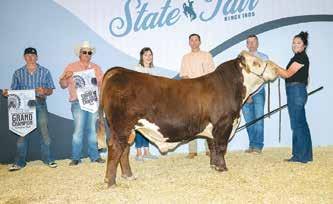
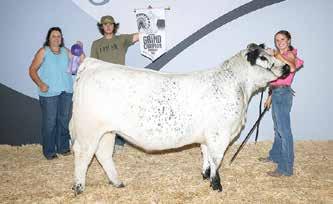

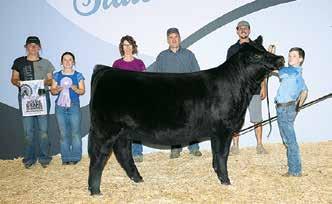

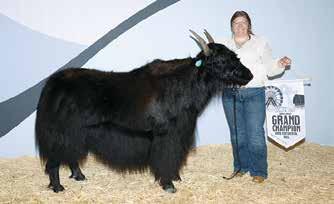

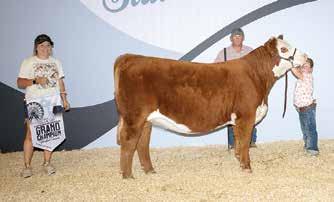
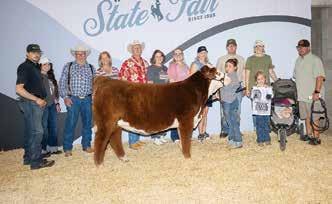


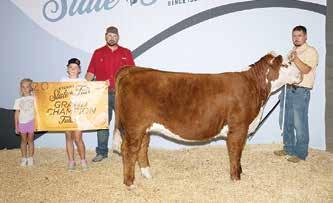
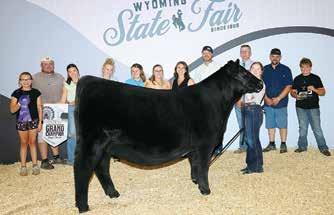
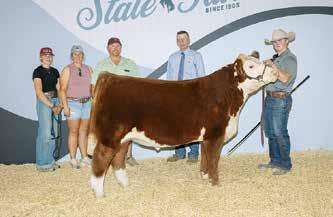

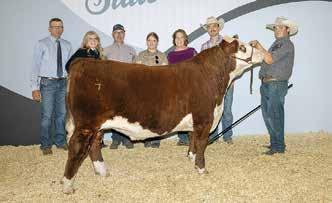
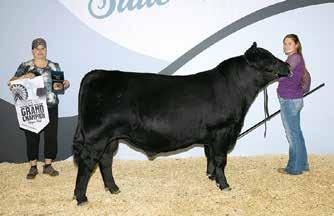
opportunities and barns full of some of the best livestock in the West – the 2025 WSF brought back some of its most popular attractions including a headlining Friday night concert, unique eats through Fair Food Flights, exciting entertainment by Dock Dogs, the ever-popular Wyoming Ranch Rodeo Finals and the prestigious Champion of Champions Showcase.
The 2025 WSF also featured the Miss Rodeo Wyoming pageant, entertainment by Sword Swallower Dan Meyer, sheep shearing demonstrations, the annual Cowboy Cornhole Tournament, the state 4-H livestock judging contest, two nights of Professional

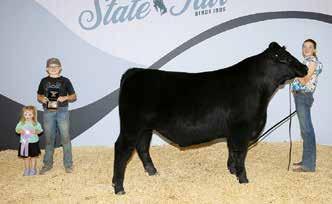
Rodeo Cowboys Association rodeo and much more.
See below for highlights from some of those who came out on top.
For a full list of 2025 WSF results, visit wystatefair.com
And, at the heart of the hustle and bustle, Wyoming livestock producers and exhibitors had the opportunity to show off months of hard work and dedication in a week’s worth of livestock shows.
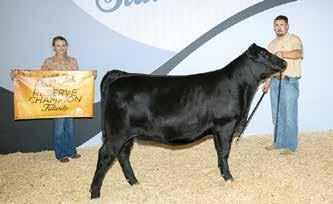



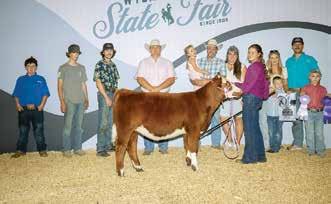
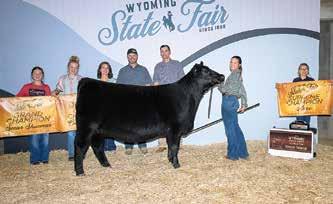



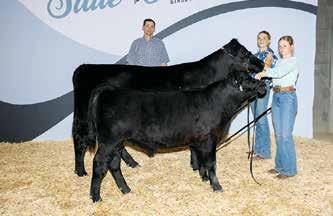
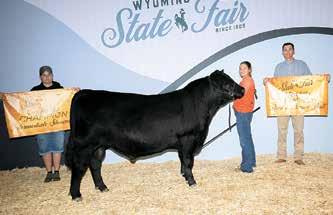



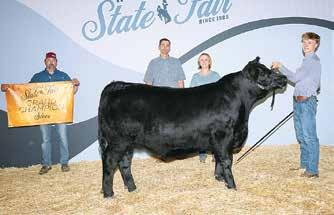

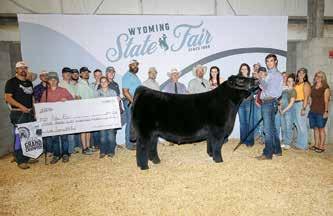


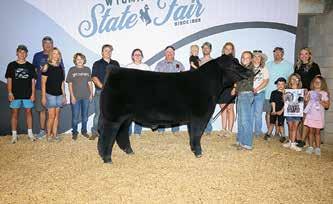
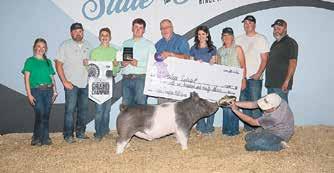
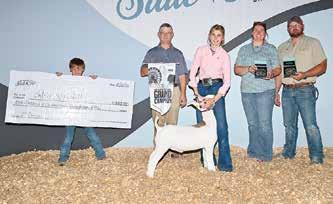
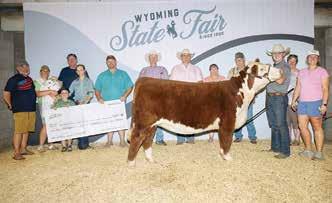


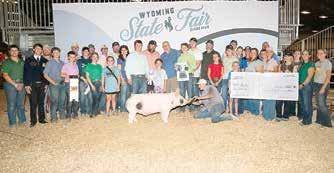



Rodeo has been a hallmark of the annual Wyoming State Fair (WSF) for over a century. Since becoming sanctioned by the Professional Rodeo Cowboys Association (PRCA) in the 1960s, the annual WSF Rodeo has proved a popular stop along the summer rodeo trail for professional athletes hailing from Wyoming and beyond.
This year’s WSF PRCA Rodeo was held Aug. 13-14 in the Ford Grandstand Arena. In addition to the classic rough stock and timed event competitions during each performance, crowds enjoyed the crowning of Miss Rodeo Wyoming 2026 and special performances including the Stars ‘n Spurs Military Appreciation Preshow.
“We’re proud of the growth and success of the WSF PRCA Rodeo this year,” says WSF Rodeo and Special Projects Coordinator Rebecca Podio. “Entries and ticket sales were up across the board, and the energy in the arena was incredible.”
Following two nights of exciting competition, champions took home their portions of a nearly $65,000 total payoff and continued their summer runs.
Bareback, saddle bronc and bull riding
Three Wyoming cowboys came out on top in the bareback riding.
Diamondville native Donny Proffit took first place and a check worth $1,154 with his 83-point ride aboard Muddy Creek Pro Rodeo’s High Road.
Eian Smith of Pinedale picked up second in the bareback riding with an 80.5point marker, followed by Evanston native Myles Carlson in third with 77.5 points.
First place in the saddle bronc riding was split between Colby Smith of Burns and Kersey, Colo. Cowboy Jade Taton. Smith and Taton each found the
whistle for 79 points to bring home checks worth $1,308 apiece.
New Underwood, S.D. native Eastan West scored 78.5 points to finish third in the saddle broncs.
In the bull riding, two out of three top spots went to Wyomingites.
Lusk native Colton Coffman brought in 83 points aboard Muddy Creek Pro Rodeo’s Speak Easy to take first prize and a check worth $1,315.
Mason Spain of Forney, Texas took second with an 82-point ride, followed by Emmit Ross of Laramie who scored 80.5 points. Tie-down and team roping
In the tie-down roping, Trevor Thiel of Greeley, Colo. finished first with a time of 9.5 seconds to take the win and a payout worth $1,840.
Second place in the tiedown roping went to Clayton Collmorgen of Cheyenne, who tied his calf in 9.6 seconds.
Third place was split between Salem, Utah Cowboy Brit Bradford and Brodey Clemons of Weatherford, Texas, both of whom stopped the clock at 9.7 seconds.
The top time in the team roping went to a pair of South Dakota cowboys. Guy Howell of Belle Fourche, S.D. and Logan Schliinz of Whitewood, S.D. turned their steer in 5.1 seconds for a firstplace finish worth $1,686 apiece.
Colorado duo Brayden Fillmore of Pueblo, Colo. and Cody Lansing of Cortez, Colo. came in second with a time of 5.5 seconds, followed by Wyomingites Bodie Herring of Veteran and Kash Reynolds of Rozet who stopped the clock at 6.1 seconds to take third place.
Steer wrestling In the steer wrestling, Jaden Whitman of White-


hall, Mont. came out on top, throwing his steer in 4.1 seconds to take first prize and a $1,411 payout.
Joe Wilson of Martin, S.D. followed suit with a time of 4.4 seconds, while Pueblo, Colo. Cowboy Cody Pratt came in third with a time of 4.7 seconds.
Barrel racing Colorado ladies earned the top three times in the barrel racing.
First, Loralee Ward of Fort Lupton, Colo. stopped the clock in 17.36 seconds to clinch the fastest time of the rodeo and a check worth $1,352.
Laura Lambert of Wiggins, Colo. finished second in the barrels with a time of 17.47 seconds, followed by Cheryl Kennedy of Bennet, Colo. with a time of 17.49 seconds.
Steer roping and all-around
In the steer roping average, Billy Good of Wynnewood, Okla. finished first with a time of 32.4 seconds on three head. Good earned $1,863 for his first-place finish.
Taylor Santos of Creston, Calif. finished second in the steer roping average with 33.3 seconds on three head, followed by Grandview, Texas Cowboy Brian Garr with an aggregate time of 34.6 seconds.
All-around honors went to Tyler Waters of Stephenville, Texas. Waters competed in the team roping and steer roping to take home the title and a check for $1,691.
Grace Skavdahl is the editor of the Wyoming Livestock Roundup. Send comments on this article to roundup@wylr.net.
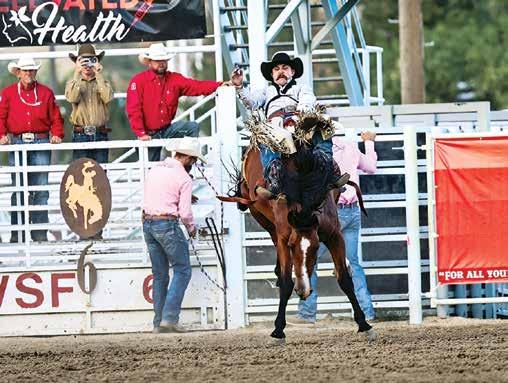
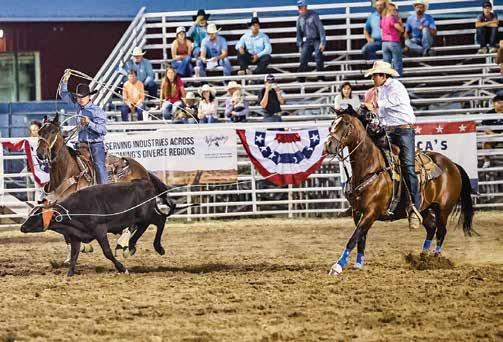
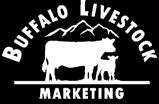
Austin Snook • 307-290-2161
Taylor Snook • 307-290-2273
Craig Deveraux • 307-746-5690
Dan Catlin
August 20, 2025
Light test on all classes, Yearlings off grass in high demand. Thank you and we appreciate your business!



Aug. 27 One Big Beautiful Bill Act Agriculture Tax Provisions Webinar, 1-2:30 p.m., online. For more information or to register, visit farmers.gov
Aug. 28 Wyoming Rescue Mission Sermon on the Mount, Wyoming Rescue Mission Recovery Ranch, Douglas. For more information or to RSVP, call 307224-7008.
Aug. 29-30 Click Thompson Rodeo Photography Workshop, Fort Worth, Texas. For more information or to RSVP, call 817-823-2675 or e-mail clickthompson@ gmail.com.
Aug. 29-31 Up In Arms LLC Flea Market and Gun Show, the CAM-PLEX, Gillette. For more information, call 208-420-2295.
Aug. 30 Wyoming Game and Fish Department Bear Spray Training Event, 10 a.m., Wyoming Game and Fish Department Cody Regional Office, Cody. For more information, contact Mark Aughton at 307-527-7125.
Aug. 31 Wyoming Game and Fish Department Bear Spray Training Event, 2 p.m., Wyoming Game and Fish Department Lander Regional Office, Lander. For more information, contact Mark Aughton at 307-527-7125.
Sept. 4-6 Stockmanship and Stewardship, Springfield, Mo. For more information, visit stockmanshipandstewardship.org
Sept. 5-7 44th Annual Hells Canyon Mule Days, Wallowa County Event Center and Fairgrounds, Enterprise, Ore. For more information, visit hellscanyonmuledays.com
Sept. 6 University of Wyoming Extension Homesteading Rendezvous, 8 a.m.-4 p.m., Clay Pathfinder Building, Laramie County Community College, Cheyenne. For more information or to register, visit bit.ly/homestead25
Sept. 6 Wyoming Game and Fish Department Bear Spray Training Event, 10 a.m., Wyoming Game and Fish Department Pinedale Regional Office, Pinedale. For more information, contact Mark Aughton at 307-527-7125.
Sept. 6 Wind River Wild Horse Ranch Day, 10 a.m.-2 p.m., Wind River Wild Horse Sanctuary, Lander. For information, visit blm.gov/whb/events, e-mail wildhorse@blm.gov or call 866-468-7826.
Sept. 7 Wyoming Game and Fish Department Bear Spray Training Event, 2 p.m., National Elk Refuge and Greater Yellowstone Visitor Center, Jackson. For more information, contact Mark Aughton at 307-527-7125.
Sept. 9 97th Annual Wyoming State Ram Sale, 11 a.m., Wyoming State Fairgrounds, Douglas. For more information, visit wyowool.com
Sept. 9 Wyoming Game and Fish Department Landowner of the Year Award Ceremony, Lander. For more information, visit wgfd.wyo.gov
Sept. 10-11 Montana Wool Growers Association 100th Annual Ram Sale, Miles City, Mont. For more information, visit mtsheep.org or call 406-442-1330.
Sept. 10-11 West Greeley Conservation District Ranching for Profit Workshop, 9 a.m.-3 p.m., West Greeley Conservation District Office, Greeley, Colo. For more information or to RSVP, e-mail leroy.hall@wgcd.org or call 970-230-7025.
Sept. 11-13 Women in Ranching Education and Development Series, Canyon, Texas. For more information or to register, visit ancw.org/wired
Sept. 12 Homesteader Days Festival Farm-to-Table Dinner, Homesteader Museum, Powell. For more information or to purchase tickets, visit homesteader museum.com
Sept. 12-13
Returning to the Ranch Workshop Series, West Central Research, Extension and Education Center, North Platte, Neb. For more information or to register, visit cap.unl.ed/returning25
Sept. 12-13 Bureau of Land Management Wyoming Wild Horse and Burro Adoption Event, Wyoming Honor Farm, Riverton. For information, visit blm.gov/whb/ events, e-mail wildhorse@blm.gov or call 866-468-7826.
LIVESTOCK AUCTION LLC
bighornbasinlivestock.com

Call to Consign Cattle Sale Barn: 307-347-9201 Danny Vigil: 307-388-0781
Visit Cattle USA for broadcasting and online bidding – auctions.cattleusa.com
Sept. 4 – Weigh-Up Special w/ All Class Cattle
Sept. 11 – Yearling Feeder Special w/ All Class Cattle
Sept. 18 – All Class Cattle, Sheep & Goats
Sept. 25 – All Class Cattle
Sept. 29 – Monday • The Bawl of the Fall Feeder Special
October 2 – Weigh-Up Special w/ All Class Cattle
October 9 – All Class Cattle
October 13 – Monday • The Bawl of the Fall Feeder Special October 16 – All Class Cattle, Sheep & Goats
October 23 – Weigh-Up Special w/ All Class Cattle
October 27 – Monday • The Bawl of the Fall Feeder Special October 30 – All Class Cattle
Construction on the scales is coming along! We will be tearing out the indoor ring to put in ring scales the months of July and August. Due to the construction, we will not be having any live auctions during these months.
We apologize for the inconvenience this may cause. If you have livestock that you need to market during these months, please contact Danny Vigil at 307-388-0781 or the office at 307-347-9201. We will start with our first Thursday sale on September 4, 2025. We appreciate your understanding.
Weber • Field Rep & Auctioneer • (307) 331-2222
Aug. 23-26
Aug. 24
Lauing Mill Iron L Ranch 20th Annual QH Production Sale, online auction only, prohorseservices.com, 605-347-6193, 605-280-0698, 605-280-0398, lauingmillironlranch.com
RQHBA 25th Annual Horse Sale, Besler’s Cadillac Ranch, Belle Fourche, S.D., 605-347-1964, 605-639-9482, rqhba.com
Aug. 27-Sept. 9 Jack Verbree Retirement Online Auction, 208-431-9300, 208-595-8561, bigmountainauctions.com
Aug. 30
Aug. 30
Proffit Ranch 24th Annual Labor Day Horse Sale, Diamond X Barn, Evanston, 307-723-5857, proffitranch.blogspot.com
Huskerland Horse Sale Extravaganza, Burwell Livestock Market, Burwell, Neb., 308-383-0039, dvauction.com
Aug. 30 Sundance Select Horse Sale, Crook County Fairgrounds, Sundance, 307302-2090, 307-281-2273, 662-538-5110, sundanceselecthorsesale.com
Sept. 9 97th Annual Wyoming State Ram Sale, Wyoming State Fairgrounds, Douglas, 307-265-5250, wyowool.com/ramsale
Sept. 10 12th Annual Montana Ewe Sale, Eastern Montana Fairgrounds, Miles City, Mont., mtsheep.org
Sept. 11 100th Annual Montana Ram Sale, Eastern Montana Fairgrounds, Miles City, Mont., mtsheep.org
Sept. 11
Cattle Country Video Frontier Fall Roundup, Cheyenne Frontier Days Event Center, Cheyenne, 888-322-8853, cattlecountryvideo.com
Compiled by Dick Perue rrichardperue@gmail.com


In the Oct. 11, 1905 issue of the Douglas Budget, Editor and Publisher Bill Barlow wrote the following in his column titled “Sagebrush Philosophy Done Into Some Scintillating Solecisms.”
It was a strenuous week – but what a winner! Wyoming has shown the world, and Douglas has made good all along the line.
With a state appropriation insufficient to provide half the necessary buildings – to which our people readily added almost as much or more, without previous experience and in the face of obstacles which a month ago were pronounced insurmountable by the pessimist – Wyoming’s first state fair passes into history as a success.
Who did it and how?
As will be remembered, Dr. M. Jesurun of this city was named by Gov. Bryant Butler Brooks as president of the state fair commission, soon after the passage of the bill creating this body.
A few days later, Jesurun disappeared and has never been seen or heard of since.
Following weeks of waiting, during which much valuable time was lost, the office was declared vacant and later filled, at the request of his neighbors and admirers throughout the state, by the appointment of Hon. James M. Wilson of Douglas.
Wilson positively and repeatedly refused the appointment at first, pledging his best efforts in behalf of the enterprise all the time, but urging other semipublic demands upon him as well as large business interests, occupied all of his time.
Later, under stress of pressure from all sections of the state and a pledge of unqualified support from the people of his own town, he accepted, and the fair – together with Douglas’ reputation for enterprise – were saved.
Few people realize the work done by this man during the few months which remained. Few know of the money and time he has spent, freely and without whine or whimper. Few take cognizance of the marvelous energy and statesmanlike diplomacy and foresight he has displayed through it all – save and except, perhaps, those who have been closest to him and have worked with him and who, as I know, have marveled many times through it all at the strong will and dominating personality – to say nothing of constant self-sacrifice of personal comfort and personal interests – which culminated last week in the triumphant advent of Wyoming’s first state fair.
From Chicago; to Omaha, Neb.; to Denver; to Cheyenne and other points about the state versus dozen times – ever the cheerful optimist in the face of indifference or occasional sectional prejudice – in his hands always a booster’s banner.
Now it is all over and one can look back and count the cost, I can only wonder at his wonderful executive ability, his willingness to work day and night and all the time his fortitude in the face of difficulties innumerable and his months of sacrifice of money and effort with no hope of recompense.
The fair was a success. Let it be admitted here and now it was Wilson who made it so.
Second only on the list of those to whom town and state owe a debt of gratitude in this connection is Charles “Charley” F. Maurer, chairman of the citizens’ committee. It will be said of Maurer someday he was the best booster Douglas ever had – as those who know him best say now.
No matter what the obligation may be, Charley has never yet scored a failure or neglect of duty during the 19 years he has lived among us. Once his pledge is given, he must make good, and all know just what this means.
To his earnest, persistent efforts and his wise foresight in planning wearisome detail and marshalling oft time lagging assistants, success was due in great measure.
And there are others – the local committee, businessmen and citizens, generally everybody boosted cheerfully and took hold and worked willingly. It was this long pull, and strong pull all together, which won.
It would be manifest ingratitude to close this comment without credit to the Chicago and Northwestern railway company and its officials, from top to bottom.
Beginning with the munificent life lease of lands worth $10, and on down the list of concessions and donations leading up to the fruition of the enterprise, these gentlemen have likewise made good and have readily granted every reasonable request made.
The Burlington and Union Pacific also did their share. It was anything to ensure success.
It was the first. We have learned something and will profit by experience. It has cost us time, money and effort, but everybody went home pleased and in this we have ample recompense.

It didn’t take long after 1905 when the Wyoming State Fair was chartered to become an economic factor in the town of Douglas, as noted by this 1906 advertisement which appeared in Bill Barlow’s Budget. A cutline under the buggy reads, “These are the carriages which took first premium at the Wyoming State Fair held in Douglas in October and comprised the very best vehicles made for the money suitable to the needs of this section. We carry this and other styles in stock. Let Us Figure With You.” Image from the Nov. 6, 1906 Douglas Budget. Historical Reproductions by Perue
Source:
AMS Livestock, Poultry & Grain Market News, Torrington
Source: USDA AMS Livestock, Poultry & Grain Market News, Greeley, CO
National Sheep Summary As of August 15, 2025
Compared to last week slaughter lambs steady to instances of 5.00 higher. Slaughter ewes sold with higher undertones. All sheep sold per hundred weight (CWT) unless otherwise specified. Slaughter Lambs: Choice and Prime 1-3 San Angelo: 60-70 lbs 230.00; 70-80 lbs 226.00-246.00. Billings: No test.
Ft. Collins: 50-60 lbs 210.00; 60-70 lbs 210.00-215.00; 80-90 lbs 202.50-220.00; 90-100 lbs 205.00-210.00; 110-120 lbs 220.00; 120-130 lbs 186.00-190.00; 130-140 lbs 187.50195.00.
Sioux Falls: 50-60 lbs 255.00-280.00; 60-70 lbs 220.00 230.00; 70-80 lbs 220.00225.00; 80-90 lbs 220.00-240.00; 90-100 lbs 210.00-245.00; 100-110 lbs 220.00-227.00; 110-120 lbs 120-130 lbs 220.00226.00; 130-140 lbs 219.00-233.00; 140-150 lbs 230.00235.00.
Equity Coop: No test. Slaughter Ewes San Angelo: Good 2-3 95.00-116.00.
Billings: No test.
Ft. Collins: Good 2-3 80.00-125.00; Good 4-5 80.00-122.50. Sioux Falls: Good 2-3: 90.00-110.00; Good 4-5: 85.00110.00; Utility 1-2: 75.00-110.00. Feeder Lambs: Medium and Large 1 San Angelo: 40 lbs 274.00.
Billings: No test.
Ft. Collins: 80-90 lbs 200.00; 90-100 lbs 195.00; 100-110 lbs 185.00. Sioux Falls: 40-50 lbs 265.00-285.00; 50-60 lbs 250.00265.00; 60-70 lbs 255.00; 70-80 lbs 240.00. Equity Coop: No test. Replacement Ewes: Medium and Large 1-2 San Angelo: No test.
Ft. Collins: No test.
South Dakota: No test.
Billings: No test.
Sheep and lamb slaughter under federal
Source:
shut off earlier than normal to conserve water. Most districts will be shut down by September 1st. Some tonnage is short due to lack of irrigation water and producers are hoping for a slight increase in the price per ton because of it. Some old crop hay sitting around in various places of the state.
-
Alfalfa/Orchard Mix - Good
Alfalfa/Orchard Mix - Fair/Good
Source: USDA AMS Livestock, Poultry & Grain Market News Torrington
Colorado Hay Summary
As of August 8, 2025
Compared to last report: Trade activity and demand moderate. Small squares of horse hay sold mostly steady. According to the U.S. Drought Monitor’s High Plains Summary for August 12, 2025, rainfall varied in intensity across the High Plains Region once again this week, with abundant rainfall amounts falling on much of North Dakota, southern Nebraska, and some spots in Kansas leading to improved conditions. Some improvement was also noted in part of the southeast Wyoming High Plains. Meanwhile, less precipitation kept dryness and drought approximately unchanged across South Dakota, and allowed for areas of intensification for the second consecutive week in central and western parts of Colorado and Wyoming. A sizeable swath of northwestern Colorado deteriorated into exceptional drought (D4), and D2 to D3 conditions expanded in other areas over and near the higher elevations in western parts of the High Plains Region. Since early July, USDA indicated that the proportion of topsoils short or very short of moisture increased from 20 to 32 percent in Colorado, and from 52 to 63 percent of Wyoming. In Colorado, 19 percent of the corn crop is in poor or very poor condition (up from just 1 percent in early July) while in Nebraska, one-third of the oat crop is in poor or very poor condition (up from 5 percent in early July). The next available report will be Thursday, August 28, 2025.
& Northwest

UP IN ARMS, LLC FLEA MARKET AND GUN SHOW AUG. 29-31 Gillette, WY at the CAMPLEX. Open to the public. Fri., Aug. 29, 3 p.m.-7 p.m. Sat., Aug. 30, 9 a.m.-5 p.m. Sun., Aug. 31, 9 a.m.-3 p.m. Giving away a .22 pistol Sunday at 2 p.m., must be present to win, 21 years of age and able to pass background check. Buy, sell, trade. Adults $6, children 12 and under free (when accompanied by an adult). For more information, contact Lisa, 208-420-2295 8/23
FLYING X RANCH OUTSIDE OF WHEATLAND, WY, IS LOOKING FOR SOMEONE FOR HOUSEKEEPING/OFFICE FILL-IN: We are a 23,000 acre remote private recreational ranch. Duties include cleaning 15 cabins, bath houses, the ranch house and pool bathroom. Also, covering the office, checking partners in and out, answering the phone, doing the pools (with training) on days covering the office, helping with events and any other duties as needed. Main responsibilities are housekeeping. The Flying X Ranch is not a developed dude ranch. The focus has always been to stay rustic and to keep the natural beauty of the property. We are a fun group of people, both employees and partners. Amenities include 23,000 acres, 8 stocked lakes, horses, ATV trails, indoor pools, game room, gun range, trap shooting and archery range. Employees have access to all of it on days off. Housing is available. $15/hour to start. Please send resume or job history with skills listed to fxr@myfxr. com 9/13
LOOKING FOR A FULL-TIME FARM/RANCH EMPLOYEE:
Seeking a motivated individual to assist in day-to-day operations of our working ranch. The role supports the current foreman and works alongside to ensure smooth and efficient operation of livestock, haying, equipment and facility management. Applicant must have a strong agricultural background and a hands-on approach to problem solving and daily ranch work. The position is long term and offers a clear path to increased responsibilities, pay and leadership over time. Location of the ranch is remote. Housing is provided and on a school bus route. Position open immediately. Please send resume with references by mail or e-mail to: PeeGee Ranch, 1251 Lower Powder River Road, Arvada, WY 82831, pgranch@rangeweb.net. Call 307-736-2461 9/6



Career Opportunity:
The University of Maryland is seeking a skilled and experienced Manager to lead the Wye Angus Cattle Program - a nationally recognized herd renowned for its legacy of genetic excellence, performance and integrity. This position is located on Maryland’s Eastern Shore. Benefits: Health, dental, tuition remission, generous paid time off & holidays, retirement and more. Salary will commensurate with experience.
For more information and to apply visit: go.umd.edu/JR102031
Best Consideration Date: September 1. EOE/AA
CORRECTIONS AGRICULTURE CROPS PROGRAM
SUPERVISOR: Are you a seasoned ag leader wanting to make a real difference?
Join Wyoming’s Department of Corrections as a Corrections Agriculture Crops Program Supervisor in Riverton, WY. You’ll manage everything from seed planting to harvest, supervise inmate workers and teach essential life and vocational skills while supporting livestock feed programs and sustaining farm equipment operations. Three to 4 years’ experience in agriculture/ farming or bachelor’s in ag. Knowledge of crop science, irrigation and farm equipment. Strong leadership and safety awareness. Rewarding opportunity to contribute to public safety and inmate rehabilitation. $24.78/hour plus full benefits: Tuition reimbursement, retirement, health care. Riverton, WY, Wyoming Honor Farm. Learn more and apply www.governmentjobs.com/careers/wyoming/ jobs/4943010/correctionsagriculture-crops-programsupervisor-2025-01356
Grow with us, help cultivate futures, both in the field and beyond. #WyomingJobs #Agriculture #Reentry #PublicService #LeadershipOpportunity 8/30
BIRD AND ANIMAL AUCTION SUN., SEPT. 21 : Selling a variety of chickens, geese, turkeys, peacocks, ducks, goats, hoof stock and more. The sale starts at 9 a.m. at the Dawson County Fairgrounds, 1000 Plum Creek Pkwy., Lexington, NE. For more information call Jaiden, 308-2331799. Find us on Facebook, JGrace Auctions 9/13
AGRI-ONE FINANCIAL: Farm/ ranch and all commercial loans. RATES AS LOW AS 5%. We have been helping with all aspects of agricultural, commercial financing and management for years. LET US HELP YOU on a consulting level with management to increase profitability, deal with and fix credit problems and for all your financing needs. WE CARE AND HAVE WORKING PROGRAMS designed for the farmer/rancher and not the banker. Please call Steve, 303-773-3545 or check out our website, www.agrionefinancial.com. I will come to you and get the job done!! 9/6

at 303-913-2493, leave a message if no answer 8/16

MINI SHEEPADOODLES: Mom (mini sheepadoodle) first generation AKC Old English sheepdog/AKC toy poodle. Sire of this litter is a 5 lb. AKC toy poodle. Perfect little lap babies. Small, healthy, home raised, beautiful babies. UTD on shots, vet checked, microchipped, pellet box trained. $900-$2,000. May be able to help with delivery. Call 307-272-3180. To view photos, go to www.wylr.net in the classifieds 9/13
REGISTERED BORDER COL-
LIE PUPPIES: Parents aggressive, good heelers, first shots and wormed. $500. Call Jim Dacar, 307-896-6274, leave message 9/13
COYOTE HOUND PUPPIES: Out of proven hunting parents. Protect livestock from predators. Also make loyal companions. First shots. Call 719-4693190 8/30
RANGE COWS FOR SALE:
Running age, black and red, have been with a bull since June 2. Call 435-353-4065 9/6
BULLS FOR SALE: Registered yearling and 2-year-old Black Angus range bulls for sale private treaty. Good selection for heifers and cows. From popular sires and industry leaders. Semen tested and ready to go. CLAY CREEK ANGUS, 307762-3541, www.claycreek.net TFN

REGISTERED WYOMING BRAND FOR SALE: LRC, LSS, LSH. Fees paid thru January 2029. Two fire irons, 2.5 and 3.5 inch. Three electric irons, 2.5, 3.5 and 5.5 inch. $3,250. Call or text 307-575-7065 9/6




HORSE TEAMS FOR SALE: FOURTEEN-YEAR-OLD PERCHERON GELDINGS used on farm equipment and to feed cows. Used in mountain areas and snow. A TEAM OF 4-YEAROLD PERCHERON MARES, perfectly matched, 17.1 hands, gentle. Used to feed cows and pull farm equipment. Both teams have been used for sleigh rides in the winter. For more information and photos, call 970-8464353 9/13
BACK TO SCHOOL SAVINGS!!
Large selections with great prices!! $AVE on BOOTS, BOOTS, BOOTS!!! HONDO, BOULET, JUSTIN WORK BOOTS, TWISTED X (boots and shoes) and more!! PURSES, belts, WALLETS, socks etc. WE CAN ship!! Shop Moss Saddles, Boots and Tack, 4648 West Yellowstone Highway, Casper, WY, 307-472-1872. Our family serving yours for 50 years!! Check us out on Facebook or our website 8/23
HAMP/SUFFOLK CROSS, POLYPAY/DORSET CROSS RAMS FOR SALE: These rams are big boned, heavy muscled and high performing. They are not tall frame sheep. We sell all across the Midwest. Call DJ, 605-929-0337 9/13

GERDES HAMPSHIRES HAS 32 REGISTERED PUREBRED HAMPSHIRE RAMS: Born in the winter of 2025. Our rams are big framed, fast growing with plenty of depth, muscle and bone. These are wether producing type Hampshires without excessive leg length but possess tremendous thickness of loin and leg. Rams are sired by stud rams purchased from leading Hampshire sheep breeders at national sales and are sired by sons of Unicorn, UFFDA and Jackalope. For more information, call or text Darrell Gerdes of Madison, S.D. at 402-760-0104. To view photos, go to www.wylr. net in the classifieds 8/30
WEANER PIGS FOR SALE, located in Powell, WY. For more information, call 307271-1014 1/17


CUSTOM FEEDING AND FINISHING FOR CATTLE AND SHEEP. Cactus Hill Ranch Company, Fort Collins, CO. Contact AJ Nelson, 970-372-8273 9/27
FAITHFUL FEEDERS: Heifer development, backgrounding and grass calf prep. Billings, MT. Call Ryan, 406-696-0104 4/11
PARK COUNTY, WY RANCH NEAR CODY, WY IS AVAILABLE FOR A LONG-TERM LEASE: The ranch has over 50,000 acres and supports an irrigated hay base with BOR water rights. Carrying capacity is 700 animal units yearround with hay production. Willing to split the hay ground and grazing. Please e-mail Honora Beirne (hbeirne@ acpg.com) and Melanie Giliati (mgiliati@acpg.com) for details 9/13

TRITICALE SEED READY FOR FALL PLANTING: High yield, makes excellent forage and cover crop. Can be grazed in the fall and winter and hayed in the spring. Call 308-4303457, for pricing and delivery. Phone calls only 8/30
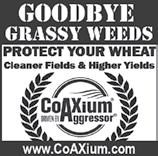
2025 HAY AVAILABLE: Round bales and small squares. Grass/alfalfa mix and alfalfa. ALSO have certified grass and alfalfa. Located in Powell, WY. Call JK, 307254-8201 9/13
COW AND HORSE QUALITY HAY FOR SALE: Grass and alfalfa hay. ALSO, forage wheat and straw. 3x4 square bales. Delivery available!! Call 307-630-3046 9/13
CERTIFIED WEED-FREE PURE
ALFALFA HAY: 2025 second cutting available in 3x3 squares, averaging 750-800 lbs. 2025 first and second cutting also available in small squares, averaging 7080 lbs. ALSO, 100+ tons of 2024 hay with weather damage. Would be good cow hay or great for compost. Will load trucks and any open trailer. MONIDA OATS: $16/ cwt. Combine run. Will auger into truck, trailer or large totes/ag bags. Located between Powell and Cody, WY. Call or text Knopp Farms for details, 307254-0554 10/11
VALLEY VIDEO HAY MAR-
KETS, LLC: Representing 40 of the best growers in eastern Wyoming and western Nebraska. Call now for your summer/fall needs, Barry McRea, 308-235-5386, www.valleyvideohay.com 9/13
HAY FOR SALE: 1,400-1,500 lb. net-wrapped bales. Alfalfa, mixed and grass. Located in Slope County, N.D. Will load. Still cutting, will have approximately 1,000 bales. $100/bale OBO. Call 701-440-1764 9/13
2014 FORD F-350 LARIAT: Crew cab, 4x4, fifth wheel hitch. Original owner. $34,500. For more information, call 719-465-4655. To view photos, go to www.wylr. net in the classifieds 8/30
2006 KEYSTONE SPRINGDALE BUMPER PULL CAMPER TRAILER, 26’ long with one 12’ slide out. Tub/shower combo. Second owner, new tires, used twice. Excellent condition. Please call 307349-2230 or 307-349-2834 for more information 9/6
2006 GMC SIERRA 3500: Extended cab, single wheel, 4x4, Duramax, Allison automatic, 138,700 miles. $20,000. Call/ text for pictures and information, 307-680-8411, if no answer leave message 8/23
2012 FORD F-650 FLATBED: 6.7L Cummins, Allison automatic. Good condition, 18’ flatbed, Vanair PTO driven air compressor, 161,000 miles. Best offer. Golden, CO. Call Eric at 720-312-9582. To view photos, go to www.wylr.net in the classifieds 8/30
FOR SALE BY OWNER: Harley Davidson 2012 Triglide, FLHTCUTG, 4,007 miles, excellent condition, $17,500. Located in Wapiti, WY, 412-849-1676, evenings 6-9 p.m. To view phowww.wylr.net
FOR SALE: WATER TRAILER with (4) 1,500 gallon water tanks, 3 cones, 2 pumps, 50 ft. hose, electric start. ALSO, International 1256 tractor and John Deere 4520 tractor. Call 701-290-2504 9/6
LODGEPOLE OUTDOOR FURNACES, 307-223-2046. Your authorized Central Boiler Dealer. Get your outdoor wood furnace today!! $2,000 tax credit on qualifying models!! Efficient wood heat. Heat multiple buildings. Invest in your heating, don’t just pay for it!! See us at www.cb.lodgepoleproducts. com!! 8/30
FOR SALE: Sitrex 7 wheel finger rake. Rowser double 9’ hydraulic mower, like new. Rowse 9’ pull type mower. Rowse 9’ 3 pt. mower. H&S 14 wheel high capacity v-rake. John Deere 3975 silage cutter with 3RN green cutter head. Two Demco 365 gravity boxes with heavy duty Demco gears. Lorenz 16’x29’ 17 ton balemover. 2024 AGT mini excavator H13R with tracks, new machine. Ford 7N tractor with wide front, runs great. Burns cattle working tub with alleyway and catwalk. Burns portable calf creep feeder. Burns portable loading chute. 2020 Freightliner, DD13 engine, automatic, 407,000 miles, aluminum wheels, very clean. Miller Pro 5100 18’ chuckwagon with bunk feeding extensions and tandem running gear. H&S 7+4 18’ chuckwagon with bunk feeding extensions and tandem 14 ton running gear. 12’ HD box scraper with
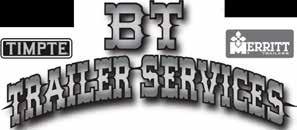
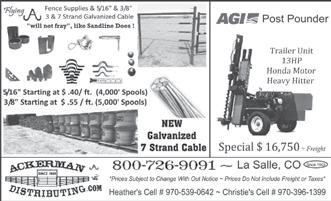
HYDRAULIC SQUEEZE CHUTE with 8’ alley and 16’ round tub. PORTABLE LOADING CHUTE Saint Ignatius, MT, delivery available. For more information and pricing, call 406-531-1036 8/30 ORIGINAL ROUND BALER BELTING FOR ALL MAKES: Save $100s. Free shipping, www.balerbelts.com. Call Hammond Equipment, 334627-3348 10/25
Tractors Wanted









When a disaster is on the horizon, timely evacuation can become that much more challenging for owners whose horses and livestock can’t simply squeeze into the back seat. These animals often depend entirely on their owners to shield them from the elements within their pasture, so having a proper plan in place is vital for their safety.
Dr. Kyle Johnson, clinical assistant professor at the Texas A&M College of Veterinary Medicine and Biomedical Sciences, offers insight into disaster risks and preparedness methods for large animal owners.
The threat of wind, water and wildfires
Natural disasters which can impact horses and livestock include seasonal concerns like extreme summer heat and winter ice, as well as sudden events like hurricanes, tornadoes, floods and wildfires.
Any storm with strong winds brings the threat of flying debris.
“When airborne, this debris can cause traumatic injuries such as lacerations and puncture wounds to horses and livestock,” Johnson said. “These high winds can also cause barns, shelters and other structures to collapse.”
Flooding brought on by a storm’s heavy rain is another major threat for large animals exposed to the elements.
“If an animal is forced to stand in floodwaters because it is confined to a stall or a flooded pasture, it can suffer from a variety of injuries, including severe dermatitis, pneu-
monia and gastrointestinal or neurological disease – collectively known as submersion injury,” Johnson said. “Floodwater can also be heavily contaminated with a variety of substances, such as petroleum products, agricultural and industrial chemicals, pesticides and bacterial organisms like E. coli.”
Completing nature’s triple threat against horses and livestock is the potential harm brought by wildfires.
“When these animals inhale the smoke from wildfires, it can cause irritation of their eyes and lungs,” Johnson said. “Animals may cough, have increased respiratory rates and nasal discharge. Fires can also destroy or contaminate any available forage for grazing animals. In these cases, animals will either need to be moved or high-quality forage will need to be delivered to them.”
“At times like these, proper animal identification is critical, as it makes returning these animals to their owners and pastures much easier after flood waters have receded and fires have been extinguished,” Johnson added.
Methods of large animal identification include microchipping, ear tags, plastic neck bands, branding and tattoos.
Thinking ahead
Simply deciding to evacuate horses or livestock isn’t enough. Having a safe place to go is also a vital part of a preparedness plan. Furthermore, knowing how to get there and having alternate routes can also be critical to an effective evacuation.
“A vital first step in any
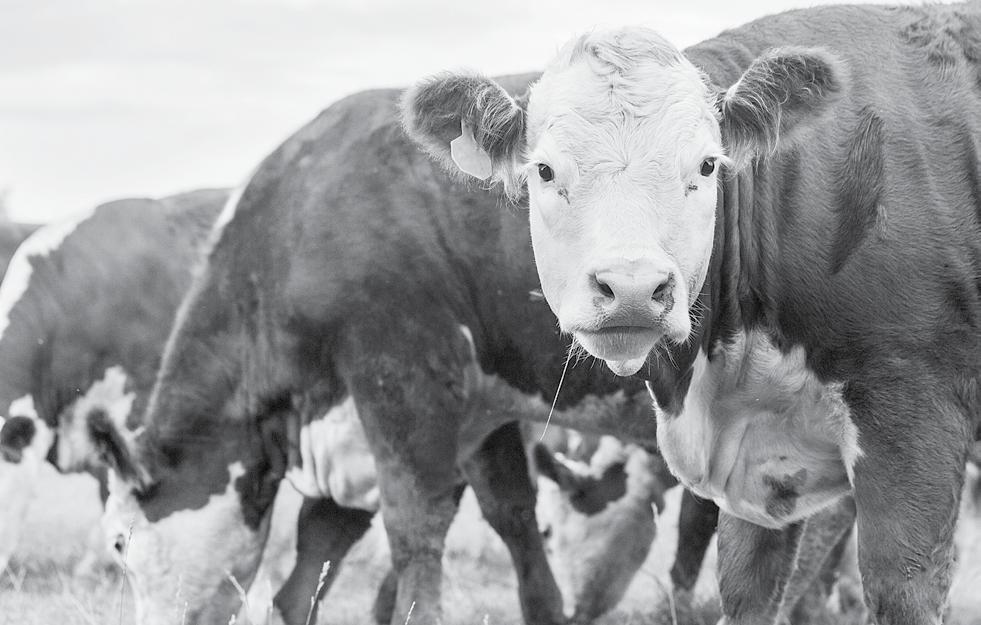
evacuation is the ability to quickly and safely load horses into a horse trailer,” Johnson said. “Practice makes perfect, so practicing loading a horse can be helpful for when you must leave. It’s also important to ensure the trailer is regularly maintained.”
A plan is merely an idea unless it is written down. Copies should be made and stored both onfarm and in alternate –but known and accessible – locations. It should also be rehearsed, even if only briefly, and everyone should have a thorough understanding of the plan and know their role.
Emergency kit preparation
Companion animal owners are encouraged to plan ahead in the event an evacuation might be needed by creating an
emergency “go kit” of necessities for their pets. Having the same kind of kit in the event one may need to evacuate large animals will make the process easier as well.
An emergency kit for large animals should contain enough supplies to last at least 72 hours and possibly up to two weeks.
“Water is arguably the most important part of an emergency kit,” Johnson said. “An adult horse needs roughly six to 10 gallons of fresh water per day. As such, a kit should include at least three days’ worth of water per horse, with enough feed to last one to two weeks.”
Additional emergency kit materials include registry paperwork, copies of medical records, firstaid supplies, identification photographs, feed and
water buckets, extra halters and lead ropes, cleaning supplies and medications.
Pre- and post-disaster resources
Before disaster strikes, an owner’s best preparation resource is their regular veterinarian, who can provide copies of important documents and ensure horses are properly vaccinated and in good health.
“It is important for horse owners to know their neighbors or, if the horse is kept in a boarding barn, the barn manager and other boarders at the facility,” Johnson said. “These relationships can promote mutual aid when disaster strikes.”
There are also a variety of resources available for members of the public to obtain accurate and up-to-date information about disasters which may impact their area, includ-
ing automated emergency alert systems in the form of texts, e-mails or apps.
Knowing how weather may affect one’s property and having a plan in place are the best ways to protect horses and herds and to stay ahead of the chaos.
“As Dr. Deb Zoran, director of the Texas A&M Veterinary Emergency Team, says, ‘Hope is not a plan.’ Owners should plan for disaster, discuss their plan with others, prepare their emergency kits and be ready to act,” Johnson concluded. “With disasters becoming more frequent and catastrophic, it’s not a matter of if, but when.”
Pet Talk is a service of the Texas A&M University’s College of Veterinary Medicine and Biomedical Sciences. This article was originally published on Aug. 7.


As a Wyomingite, I tend to be quite fond of the way in which I have been accustomed to live. What I mean by this is I like my space.
I like walking to my office every morning in my yard, managing my schedule on my own behalf, making my own deals and managing my own business in my own yard. I guess in some ways this might sound a bit selfish, but the life my wife and I have chosen to build has shaped my independence, my perspective and, in large part, my interpretation for what embracing the American way of life is all about.
My vision for my own future has always been about creating a balance between work and family, raising three boys in an
BY RON RABOU
environment which encourages a healthy mix of work and curiosity, as well as an opportunity to explore and embrace their own passions.
It’s been about creating mental and financial independence – which I seem to be constantly working on –and it’s been about creating enough freedom for myself to be immersed in helping make where we live a better place.
It has always been my goal to share my experiences, heartaches and triumphs with others in a way I hope helps their lives to become better as a result.
You and I are likely more alike than we are different. We may not have the same political beliefs, the same interests or even the same goals, but at our core
my guess is we more than likely agree on core values and the things that are the absolute most important to us – three of which would be faith, family and friends.
I find the hard part is that not every day is the same, and I suppose this is a good thing. Perhaps you feel the same way I do. Not every day is great. Some days are downright hard. Some days, the little things bother me, or if I am completely honest, some days everything bothers me.
Some days, nothing seems to go right. No matter what I do or how I do it, I end up with a big crap sandwich. I’m not particularly fond of those days, by the way.
Then, on other days I can seem to do no wrong. Things of all sorts seem to fall into place. Everything just works. In case you’re wondering, I love those days.
I have often pondered the difference and what causes it. Is it sleep, preparedness, proper timing, what I ate, how much I prayed or is it just luck?
Conclusively, I have
decided I have no idea.
Perhaps it’s not within my capacity as a human being to understand what causes both good days and bad, but rather it is within my field of control to determine I must move forward and handle each challenge, failure and success with a positive mindset and humble heart and the understanding I must learn from each experience, regardless of the process or the outcome.
Here’s what I do know. The Lord works in my life in untold ways to teach me the things I lack the most –patience and control of the unknown.
I understand both of those things. I’m a farmer, after all. It’s something our farm and family face every single day. The very nature of what we do means while we can do everything nearly perfectly, ultimately the weather determines our fate. This can be a tough pill to swallow.
I spent this past weekend in one of my favorite places with one of my favorite people – on a farm in the Midwest at an antique tractor
show with my son Spencer.
As we both found ourselves gazing across the rolling, green landscape covered with trees and crops the best farmers would envy, Spencer said something to me I’ll never forget.
“Everyone thinks the world is falling apart and everything is horrible,” he said. “It’s all because they haven’t been to rural America.”
This statement could not be more profound, nor could it be more true.
Sometimes, I think we all have it too easy.
Don’t mishear me, I don’t know you, and I’m not saying you have an easy life. Rather, what I am saying is we live in such a free society, in such an incredible country and we have access to anything and everything we could possibly want or do or say, and the ease of access we have to so many things, it’s just easy to lose perspective.
So when we have a bad day, or listen to too much negative news, or scroll too much social media, or spend too much time focus-
ing on the negative or the things that are wrong, or when we focus on arguing and fighting with those who have differing political views from our own, we lose sight of all of the good and all of the blessings that flood each and every one of our lives.
Maybe we could all use a dose of the way farmers in rural America live.
There is no greater hope or faith than planting a seed in the ground and hoping the weather cooperates enough to provide a harvest bountiful enough to meet our daily needs.
It’s what we should all do. Plant a seed of positivity, manage and eradicate the weeds of negativity, pray and have faith all will end well.
The ability to embrace this mindset is within us all. Imagine the world if we did. Ron Rabou is president of Rabou Farms, Inc. in southeastern Wyoming, a nationally known author, speaker and co-host of the nationally-syndicated podcast AgInspo. For more information, visit raboufarms.com
much of the West, with temperatures well above normal and very low humidity in several states,” NIFC continues. “Scattered storms may bring lightning from California to Wyoming, creating the potential for new ignitions at the same time wildland fire personnel are working hard to contain existing fires.”
Wyoming wildfires
Currently, the Red Canyon Fire is the most significant blaze in the state of Wyoming, threatening numerous structures, ranches, guesthouses, RV campgrounds and other businesses, as well as some sprawling rural community zones.
According to InciWeb, the fire was ignited by a lightning strike on Aug. 13, 11 miles east of Thermopolis.
As of Aug. 21, the blaze had scorched a whopping 126,683 acres across Hot Springs, Washakie and Fremont counties, with 31 percent containment.
InciWeb notes the Red Canyon Fire’s rapid growth has been fueled by a combination of dry conditions and unfavorable wind and weather patterns, with firefighters battling temperatures approaching triple digits, near-zero humidity and erratic wind gusts.
The severity of the Red Canyon Fire has led to multiple evacuation orders, and on Aug. 19, Wyoming Livestock Board Director and Chief Executive Officer Steve True implemented an order allowing producers in Hot Springs, Washakie and Fremont counties to move livestock without brand inspections from the evacuation area to neighboring counties in Wyoming.
Additionally, the Sleeper Ranch Fire, ignited on Aug. 14 near Meeteetse, burned roughly 20,657 acres of grass, sage, juniper and limber pine on Bureau of Land Management and state lands along the west side of the Greybull River. As of Aug. 19, the fire was 90 percent contained.
As of Aug. 21, the Spring Creek Fire burning southeast of Ten Sleep was responsible for 3,599 acres of scorched earth. NIFC notes crews are busy securing the line and mopping up hotspots, making progress in recent days with 38 percent containment.
Other active fires blazing through the Cowboy State include the 524-acre Bull Lake Fire and 20-acre Indian Ridge Fire in Fremont County, the 145-acre Cold Spring Two Fire in Campbell County and the 39-acre Little Greys Fire in Lincoln County.
Other blazes
Widespread drought conditions have resulted in wildfire devastation across Wyomingʼs neighboring states as well.
In an Aug. 20 Mountain Journal article, Journalist Leigh Walden reports Montana’s wildfire season picked up in mid-August, with 48 new fires starting over the
course of seven days.
Walden notes more than 48,060 acres have burned in Montana since the beginning of the year, with acres burned since July 21 representing 65 percent of this total.
Some of the most significant blazes in the Big Sky State include the Horn Fire at 2,800 acres and 95 percent containment; the McAllister Fire at 3,560 acres and 50 percent containment; the Bivens Creek Fire at 2,267 acres and zero percent containment and the Cloudrest Fire at 1,190 acres and zero percent containment.
In Idaho, nine wildfires are currently burning more than 31,000 acres, according to Walden.
The Watch Duty app shows, of these, the most significant are the Big Bear Fire at 15,517 acres and 70 percent containment; the Rush Fire at 7,908 acres and 90 percent containment; the Box Fire at 4,413 acres and 54 percent containment; the Rock Fire at 2,770 acres and zero percent containment; the Island Creek Fire at 2,393 acres and five percent containment and the 1,213acre Elkhorn Fire.
In Utah, the Monroe Canyon Fire has burned through 73,722 acres in the Fishlake National Forest, with 86 percent containment as of Aug. 21, while the 5,282-acre Beulah Fire actively burns in the Uinta-Wasatch-Cache National Forest along the Wyoming border.
The state of Colorado has also been devastated by some big blazes, including the Lee Fire, which scorched 137,755 acres across Garfield and Rio Blanco counties, etching itself into history as the fourth-largest wildfire in the state – only 275 acres smaller than the historic Hayman Fire of 2002. InciWeb data shows the fire had reached 73 percent containment as of Aug. 21.
Directly to the east, the Crosho Fire had scorched 2,072 acres with 24 percent containment, while the nextdoor Derby Fire jumped to 2,625 acres with zero percent containment as of Aug. 21.
In Colorado’s southwest corner, the Turner Gulch Fire had burned through 31,699 acres with 80 percent containment; the Stoner Mesa Fire had burned 9,872 acres with 27 percent containment and the South Rim Fire had burned 4,232 acres with 60 percent containment, according to Aug. 21 data.
Robust response
In response, state and federal agencies have issued emergency declarations across these Western states, while others have set up relief funds to help those affected by the fires.
In Wyoming, Gov. Mark Gordon issued an executive order declaring an emergency response on Aug. 18, which will help the state access additional federal firefighting resources, request support from the Wyoming National Guard and direct the Office of Homeland
Security to take action in coordinating state and federal resources in response to the fires.
“Once again, wildfires in Wyoming are creating significant impacts on our communities and threatening lives and property,” Gordon states in the Aug. 18 press release. “We will continue to ensure state resources are available to those affected by these fires.”
A few days earlier, on Aug. 15, the Federal Emergency Management Agency (FEMA) approved Wyoming’s request for a federal Fire Management Assistance Grant to help with the Red Canyon Fire.
“This authorization makes FEMA funding available to pay 75 percent of the state’s eligible firefighting costs under an approved grant for managing, mitigating and controlling designated fires,” Gordon explains.
Additionally, on Aug.

21, the Wyoming Stock Growers Endowment Trust announced the renewal of its Wildfire Relief Fund to assist Wyoming livestock producers who have been impacted by major fires this summer.
“The trust is a 501(c) (3) nonprofit entity established by the Wyoming Stock Growers Association (WSGA) in 1977 to ensure the future of Wyoming’s cattle industry through support for eligible programs which include keeping the next generation of ranchers on the land,” reads the corresponding Aug. 21 press release.
“In addition to funding provided by the trust, the organization is seeking donations from businesses and individuals interested in assisting producers impacted by the fires.”
All donations are tax deductible and can be made by check payable to WSGA Endowment Trust, PO Box 206, Cheyenne, WY 82003; by credit card online at wysga.org; by credit card over the phone by contact-

To stay up to date on wildfire activity in Wyoming and across the West, visit inciweb.wildfire.gov/incidentinformation or app.watchduty.org.
ing the WSGA Office at 307638-3942 or by direct wire transfer.
The WSGA Endowment Trust will begin accepting applications for cash assistance on Sept. 1. An application form will be available at this time on the
site or by calling the
Office.
Hannah Bugas is the managing editor of the Wyoming Livestock Roundup. Send comments on this article to roundup@wylr.net.
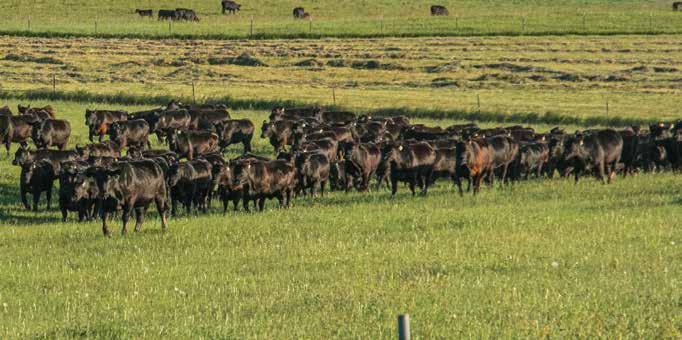

Wyoming is a dry, windy and sometimes unpredictable environment. Summers are typically very warm with occasional storms and winters are cold and dry.
For farmers who grow cover crops, the tough environment can complicate things.
Successful establishment of cover crops can be difficult without sufficient moisture and nutrients from the environment.
What are cover crops and why grow them?
Cover crops grow before or after cash crops and can help improve soil quality by adding nutrients cash crops could uptake in the future.
Plants from the legume family are the prime example for adding nitrogen to the soil because they have a symbiosis with root bacteria which fixes atmospheric nitrogen into plant-available form.
Another way cover crops improve soil conditions is by adding plant residue into the soil after they are fully grown, increasing organic matter.
Other cover crops can
Registration is now open for CattleCon 2026, which will be held for the first time in downtown Nashville, Tenn on Feb. 3-5, 2026.
Music City Center, the home of CattleCon 2026, is within walking distance from well-known attractions like Lower Broadway, the Ryman Auditorium, the Country
relieve soil compaction, move moisture up higher in the soil or even reduce weed populations through competition for resources.
Cover crops are a popular management method worldwide. In semi-arid regions like Wyoming, one of the main cover crop mixes is field pea and oats.
Researchers Elizabeth Moore and Urszula Norton from the University of Wyoming’s Department of Plant Sciences were interested in how different cover crops interact with nutrients from different soil amendments in low-moisture environments.
About the experiment
Moore and Norton’s research was conducted over a nine-week period, chosen to mimic the short window of time cover crops have to grow and establish in a growing season.
The experiment was done in a greenhouse to ensure consistent soil moisture.
Field-collected soil from a dryland farming area in southeastern Wyoming was either amended with compost, amended with an inorganic fertilizer or left as a
soil-only control. These pots were planted with different cover crop mixes, each with a different management goal correlating to the kind of cover crop mix.
The different kinds of cover crop mixes were a phacelia monoculture, a soilbuilding mix, a nitrogen-fixing mix, a mycorrhizal mix and a no cover crop control.
All pots were watered equally, but kept at a very low percent moisture to mimic the semi-arid growing conditions of Wyoming.
Findings
The soil-building mix, nitrogen-fixing mix and mycorrhizal mix all had high cover crop biomass, which is good if cover crops will be grazed or harvested, as well as for providing ground cover and increasing soil organic matter.
All cover crop mixes reduced the amount of weed biomass as well.
The soil-building mix outperformed the other cover crop mixes with the most plant biomass and the least weed biomass. The soil-building mix also had the best biological nitro-
gen fixation with no added soil amendments and good biological nitrogen fixation in soils with a compost amendment.
In general, the highest levels of biological nitrogen fixation occurred in soils with no amendment or compost added, in contrast to the least biological nitrogen fixation when inorganic fertilizer was added.
When inorganic fertilizer was present, the legumes used the nitrogen from the fertilizer rather than making it on their own.
Moore concluded having a “heavy hitter” with a couple of other species is more beneficial than having a mix with too many different species in it.
Based on this study, a general recommendation for cover crop mixtures would be to find one or two highimpact cover crop species and mix in a couple of other species with different root types.
In particular, Moore recommends plant diversity in a cover crop mix be achieved through mixing a single species from a variety of plant

families – grass, legume, mustard and other broadleaves – rather than multiple species from a single plant family.
Moore and Norton recently published their findings in the open-access scientific journal PLOS ONE
The article, titled “Improv-
Music Hall of Fame and Museum, the Johnny Cash Museum and much more.
A new highlight of the event is all registration options include access to Cattlemen’s College education sessions and demonstrations. Attendees can also look forward to a variety of other educational opportunities including the CattleFax Outlook Semi-
nar, consumer insights session and industry updates.
Pre-convention activities will begin on Feb. 2, 2026 with the Washington, D.C. issues update, regional meetings and policy committee meetings. CattleCon 2026 will officially kick off on Feb. 3, 2026.
The Prime Cut Awards Ceremony will recognize industry leaders including
the 2025 Environmental Stewardship Award Program national recipient and Beef Quality Assurance award winners. The Cattle Feeders Hall of Fame Banquet will celebrate those who contribute to the ongoing success of the cattle feeding industry.
The general session will feature New York Times Bestselling Author
Jon Acuff, and post-convention tours will round out the week.
More than seven acres of the National Cattlemen’s Beef Association (NCBA) Trade Show will provide plenty of room to engage with exhibitors, listen to educational sessions and enjoy entertainment and daily receptions. In addition, the cattle industry
TUESDAY, SEPTEMBER 2
TUESDAY, AUGUST 26
TUESDAY, SEPTEMBER 9
YEARLINGS
Eastfork Livestock- 315 Blk, BWF, RWF, small % Hereford Yrlng Strs 850-925#. 150 Blk, BWF, RWF, small % Hereford Spayed Yrlng Hfrs 800-850#. Cattle have rec Nasalgen & 7 way @ branding, Vista Once SQ & 8 way w/ Somnus @ weaning. Sired by great Herd bulls. This is a reputation set of High Elevation, High Performance Yearlings!!
CALVES
Gary Horton- 7 Blk Ang & Ang/SimX Strs(5) & Hfrs(2) 500-600#. Rec 8 way @ branding. Nice, home raised, growthy calves! BREDS
Steve Ward- 40 Blk Ang & AngX Bred ST Cows. Exposed to Blk Ang bulls to calve March & April.
TUESDAY, SEPTEMBER 16
CALF & YEARLING SPECIAL START TIME 9:30 AM W/ WEIGH UPS
YEARLINGS
Arapahoe Ranch- 200 Blk Ang & AngX Strs 700-850#. 100% All Natural, no Hormones. IMI Global certified. Grass Fed, Reputation, high gaining!! High elevation! CALF
ing semi-arid agroecosystem services with cover crop mixes,” can be viewed at journals.plos.org/plosone/ article?id=10.1371/journal. pone.0306567
Spencer Smith is a writer for UW Ag News. This article was originally published by UW Ag News on Aug. 11.
will be hard at work guiding both Beef Checkoff and NCBA policy programs. NCBA, the Cattlemen’s Beef Board, American National CattleWomen, CattleFax and National Cattlemen’s Foundation will hold annual meetings during the event. For more information and to register, visit ncba. org
TUESDAY, SEPTEMBER 23 CALF & YEARLING
TUESDAY, SEPTEMBER 30
CALVES
Arapahoe